Governor’s Office of Economic Development • 2017 Annual Report • www.business.utah.gov a
Governor’s Office of Economic Development • 2017 Annual Report • www.business.utah.gov b
Governor’s Office of Economic Development • 2017 Annual Report • www.business.utah.gov 1
Governor’s Office of Economic Development • 2017 Annual Report • www.business.utah.gov 2
Governor’s Office of Economic Development • 2017 Annual Report • www.business.utah.gov 3 Contents Executive Director Message 4 Mission and Vision 6 Strategic Plan 7 Divisions 1 Operations 10 2 Corporate Recruitment and International 11 3 Business Services 12 4 Tourism, Film and Global Branding 13 Programs 1 Grow & Support a Utah Strategic Industry Clusters 16 b . Economic Development Tax Increment Financing (EDTIF) . . . . . . . . . . . . . . . . . . . . . . 18 c Enterprise Zone 20 d Targeted Business Tax Credit 21 e Recycling Zone 22 f New Market Tax Credits 23 g Alternative Energy Tax Credit 23 h Hotel Convention Tax Credit 23 i Life Science Tax Credit 23 2 Engage Industry a Procurement Technical Assistance Centers 24 b Technology Commercialization and Innovation Program 26 c Business Resource Centers 28 d Industrial Assistance i Rural Fast Track 30 ii Business Expansion and Retention (BEAR) 31 3 Expand the Experience a. Utah Office of Tourism 32 b Utah Film Commission 35 c. Utah Office of Outdoor Recreation 37 4 Advance Partnerships a Utah STEM Action Center 39 b Utah Broadband Outreach Center 41 c Pete Suazo Athletic Commission 43 d Avenue H 44 e Private Activity Bond Authority 45 f Marketing and Communications 46 Budget 49 Boards & Councils 53 1 GOED Board of Directors 53 2 Governor’s Economic Development Coordinating Council (GEC) 53 3 Governor’s Rural Partnership Board 53 4 Utah Board of Tourism Development 54 5 Private Activity Bond Review Board 54 6 STEM Action Center Board . . . . . . . . . . . . . . . . . . . . . . . . . . . . . . . . . . . . . . . . . . . . . . 55
Dear Legislators and Partners:
I’m pleased to report a successful fiscal year 2017 and wish to share with you my top seven highlights This only scratches the surface of our successes, and I hope you take the time to explore this report and learn about our programs I invite you to pay special attention to program spotlights, as they truly capture the GOED story
While the annual report includes required budgetary information and data, it also shares what’s most important: the people Get to know our team and the people who have benefited from programs and initiatives of the Governor’s Office of Economic Development Thank you for your support

Sincerely,
Q Val Hale

Governor’s Office of Economic Development • 2017 Annual Report • www.business.utah.gov 4
Val’s Top 7 Highlights
One - Three
Rural Utah steps into the spotlight. It is our goal to build economic prosperity in every corner of the state, and we are on track to meet the governor’s goal to create 25,000 jobs in rural Utah by 2020 The 25K Jobs initiative includes county economic development plans and various tech programs to help fill high-demand Wasatch Front jobs remotely In 2017, we have seen a record number (46) of Rural Fast Track grants approved for rural businesses
Industry steps up to the plate. When it comes to workforce needs, industry knows what they need best This year marked the launch of Talent Ready Utah, an industry-led initiative to address workforce needs across several industries and communities in Utah Talent Ready Utah unites the efforts of Pathways programs including the new IT Pathways, the K-16 Computing initiative and several adult-learner programs.
Outdoor industry thrives. The Beehive State attracted several newcomers including Big Agnes, Rotor, Wild Tribute, Fisher Skis and Shred. Farmingtonheadquartered Vista Outdoor now encompasses 50 outdoor products brands . The Utah Outdoor Recreation Grant program awarded funds to 31 infrastructure projects throughout the state In partnership with the Utah Department of Emergency Management, the Utah Office of Outdoor Recreation launched the Utah Search and Rescue Assistance (USARA) card program to ensure greater protection for backcountry enthusiasts
Four - Seven
Support for homegrown companies. This past year marked some notable wins on the corporate recruitment front—including hundreds of millions in capital investment and more than 1,000 jobs from Amazon More important to us is our support for homegrown companies. Utah-based Pluralsight plans to build a whole new campus and create 2,400 jobs in the coming years
Goals surpassed. Gov Herbert set a goal in 2013 to increase travel-related tax revenues from $1.09 billion to $1.2 billion by 2020. Excellent news: we hit the target in 2016, four years ahead of time! Travelers spent $8.4 billion, generating $1.2 billion in tax revenue, which in turn supported 144,187 jobs. The Utah Office of Tourism is proactively engaged in initiatives to avoid park overcrowding and ensure an excellent tourism experience for generations to come
“Little Hollywood” rises again. Utah is back with a bang! Keeping with tradition, the state provides the perfect Western backdrop for the critically acclaimed film Wind River and popular television series Westworld. Andi Mack, a new Disney Channel series, is filming its second season in the state and has brought millions of dollars in revenue
Securing economic prosperity for future generations. What’s the point of having a winning economy if it’s not sustainable? Realtor, Apartment List, and even Time Magazine are noticing the trend: millennials are flocking to Utah With our consistently high job growth and low unemployment, the state is indeed a prosperous and attractive option for the rising generation GOED is engaged in several initiatives to address workforce challenges, diversify the economy and create sustainable economic growth We may be one of the top states for business, but our work is by no means finished—in a sense, we’re just getting started
Governor’s Office of Economic Development
2017 Annual Report
www.business.utah.gov 5
•
•
Vision Statement
Utah will lead the nation as the best performing economy and will be recognized as the premier global business environment and tourist destination .
Mission Statement
GOED’s mission is to enhance quality of life by increasing and diversifying Utah’s revenue base and improving employment opportunities


Governor’s Office of Economic Development • 2017 Annual Report • www.business.utah.gov 6
Strategic Plan

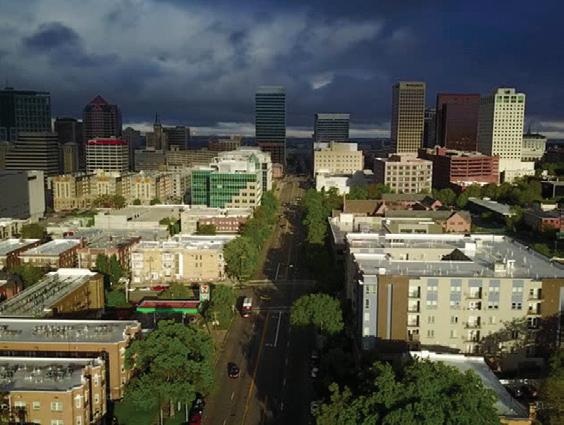

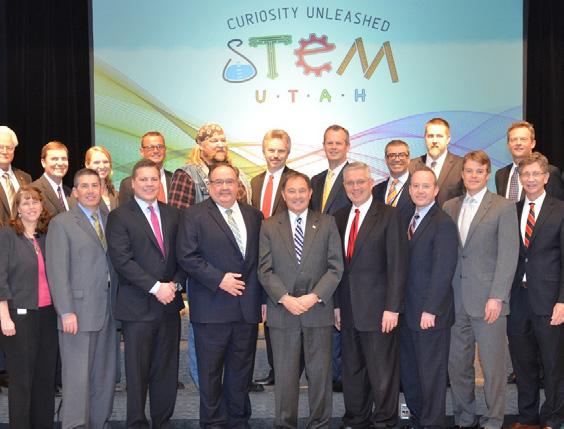
Grow & Support
Grow and support Utah businesses in our rural and urban communities and encourage the innovative entrepreneurial spirit .
Engage Industry
Engage with industry to build strategies that maintain a diversified economy and strengthen the business supply chain
Expand the Experience
Expand the tourist experience of Utah’s natural and cultural wonders
Advance Partnerships
Advance Utah’s unprecedented partnerships in industry, education and workforce development
Utah Residents will benefit from:
• Improved availability and quality of jobs
• Decreased tax burden
• Increased quality of life in their community
• New training and education opportunities for underemployed and unemployed workforce
•
•
Governor’s Office of Economic Development
2017 Annual Report
www.business.utah.gov 7

Governor’s Office of Economic Development • 2017 Annual Report • www.business.utah.gov 8

Divisions
Operations
Internal operations oversees the finance, compliance, policy, contract management, human resources, technology services, and overall facility management of the Governor’s Office of Economic Development. The operations team strives to provide innovative and creative service through continuous quality improvement in services, resources, and business relationships We recognize the importance of our stewardship over the organization’s financial and physical well-being and value collaborative and effective business procedures and controls
Data
Achievements
Salesforce integration: Salesforce is the platform GOED uses to track the EDTIF post-performance tax credit rebate. During FY 2017, we began a system clean-up as well as integration process throughout the organization
By the end of the fiscal year the EDTIF program was fully utilizing the system from application to rebate Additional programs moving toward integration include TCIP, Outdoor Recreation and Film. The Office of Rural Development also has several programs in the beginning stages of integration
By FY 2018 the goal is to have 70 percent of our programs integrated along with operational processes including travel, purchasing, and approval authorization
Conga/Docu-sign integration: Conga Contracts radically improves the contract management processing for EDTIF, Rural, OOR, and Film programs; eliminating dated email and Word document generation, minimizing errors, maximizing Salesforce data accuracy, and maintaining consistent data retention Conga Contracts replaces dated manual contract generation relying on Word and numerous tracking spreadsheets for different agency programs which resulted in a high user error rate with time consuming correction remediation
The product also automates contract generation, when a project application is approved, a contract is created at the click of a button Whether it’s the same contract type over and over, or a one-off unique contract, the system can process it . Conga’s powerful Redlining technology saves time during the negotiation process No more worries about whether Word’s Track Changes was turned off, no more line by line comparison between documents - Conga Contracts does it automatically! The team is immediately alerted to
changes from version to version during the negotiation process and can easily compare versions Once negotiations are concluded, integration with Docusign allows for near instantaneous signatures to finalize the contract with both the contracted entity and internal stakeholders Overall, the tool improves productivity and efficiency throughout the contract process
Datasharing: In the past year GOED has participated in the Center for Regional Economic Competitiveness (CREC) 5 state study on increasing data sharing within state agencies The study was inspired by the PEW Charitable Trust research on the effectiveness of incentives The PEW research discovered that effectiveness is often difficult to measure overall due to the availability of shared data across state agencies GOED and DWS have represented Utah in the 5 state study In the course of the last year, GOED has coordinated with the Tax Commission regarding additional access to tax related information, supported legislation that has increased data sharing including SB 194 and HB 25, and GOED has fortified MOUs with several agencies to increase access to relevant data sets . Utah is quickly becoming a leader across the nation and gold standard with the new legislation and best practices being put in place GOED recently presented at the annual CREC conference highlighting its efforts in data sharing and will present in a nationwide webinar in November 2017 for the National Governor’s Association
Challenges
Collecting, sharing, and protecting data is always a challenge It is not a unique challenge to GOED, and it is important we continue to work on with our partners We are often asked complex questions which require data sets from across entities. Confidentiality is vitally important to us, our partners and stakeholders; they can also be barriers to creating consistency and accuracy across reporting entities Navigating through the barriers and creating shared data is time consuming, and we do our best to be as accurate and complete as possible
Full Time Employees: 17

Governor’s Office of Economic Development • 2017 Annual Report • www.business.utah.gov 10
Reporting Year Program Number FY 2017 Finance – Transactions processed 11,964 FY 2017 Administration – Contracts processed 664 CY 2015 Compliance – Company assessments 58
Director
Contact Jill Flygare Managing
801-538-8823 jflygare@utah.gov
Corporate Recruitment & International
Corporate Recruitment accelerates business growth and job creation through sustainable, cluster-focused domestic and international corporate expansion and relocation Financial incentives are available for business relocation and expansion for select companies that create new, high-paying jobs to help improve the standard of living, increase the tax base, attract and retain top-level management, and diversify the state economy
The GOED Board provides recommendations to the executive director, who has the authority to finalize incentive amount and duration based on statutory direction and evaluation criteria . These criteria include financial strength of the company, number and salary of jobs created, amount of new state tax revenue, long-term capital investment, competition with other locations and whether the company is headquartered in Utah or in a targeted strategic industry cluster . Incentives are:
1) Post-performance, where companies met contract performance benchmarks of job creation and new state taxes,
2) Single Taxpayer, with tax credit amounts based on new state taxes generated, and
3) Competitive, in that companies must evaluate Utah against other locations
Achievements
Fiscal Year 2017 proved an active one with 19 EDTIF incentives approved by the GOED Board The companies involved were a mix of 11 headquartered outside the state and eight existing Utah companies on high-growth trajectories The majority of the projects directly support the expansion of strategic industry clusters, in particular five in software/information technology and four in the emerging sub-sector of financial technology, or “fintech.” Manufacturing/distribution projects continued strong with nine projects represented
Several projects garnered national attention, including global brands representing significant growth opportunities Amazon and UPS top this list
GOED continued to work in close collaboration with the Economic Development Corporation of Utah (EDCUtah)
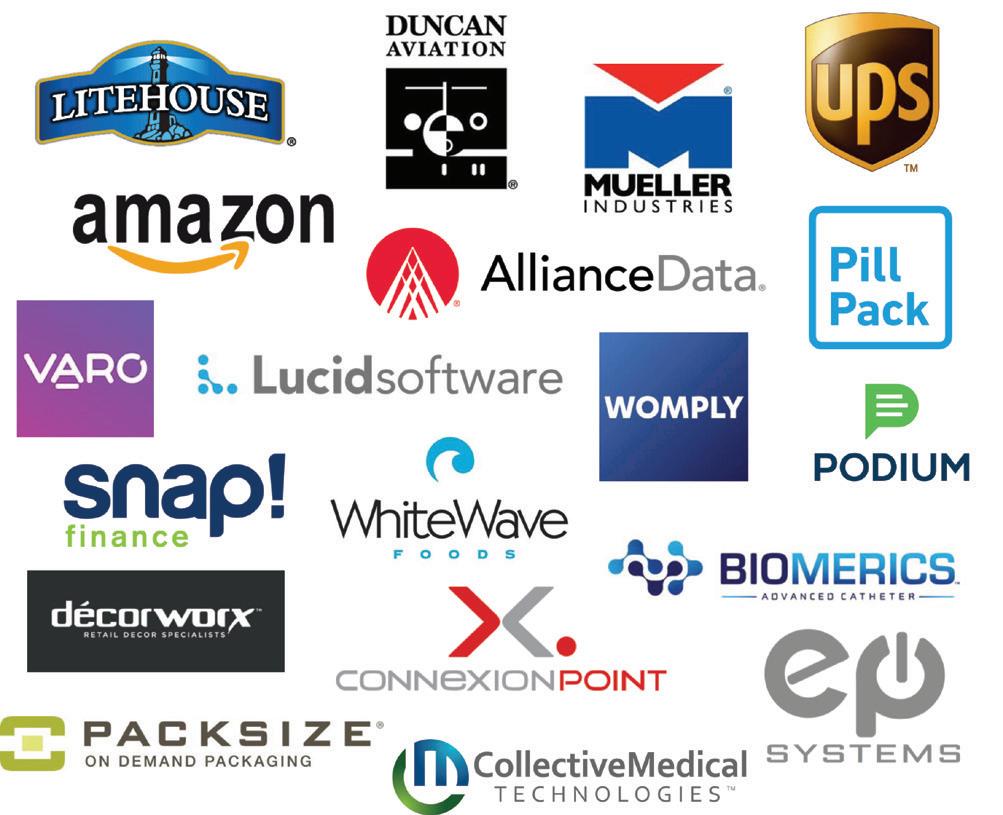
to identify and recruit out-of-state companies. Of note, the Varo Money project was the first EDTIF generated by EDCUtah’s Global Strategy & Outreach initiative The initiative shows promise for more projects in FY 2018 .
GOED’s International Trade and Diplomacy program leads out on international efforts including trade mission coordination, business mentoring, foreign direct investment attraction, and diplomatic meetings and tours It is vital that GOED’s corporate recruitment strategy also taps global markets
Challenges
On the operational side, in FY 2017, GOED incentives devoted increased resources to analyzing the pool of active EDTIF projects This effort has brought more rigor to confirming actual jobs created and new state revenues generated In parallel, GOED’s compliance team is working to streamline the reporting process for new and existing EDTIF clients
Full Time Employees: 10

Contact
Ben Hart
Deputy Director
801-538-8799
bhart@utah.gov
Governor’s Office of Economic Development • 2017 Annual Report • www.business.utah.gov 11
Business Services
GOED’s Urban & Rural Business Services (URBS) team creates and executes strategies to increase job opportunities in Utah URBS is focused on aligning its portfolio of programs and services within industries that strategically and operationally benefit companies currently in Utah while focusing on recruiting and expanding occupations that are forecasted to grow The URBS portfolio of services includes Business Resource Centers, Private Activity Bond Authority, Procurement Technical Assistance Centers, Rural Development, Technology Commercialization & Innovation Program, Workforce Development, Strategice Industry Clusters and the Utah Broadband Outreach Center URBS’s goal is to provide companies with the most comprehensive resources needed to surpass business accomplishments
Achievements
Talent Ready Utah: This program, announced by the governor during the 2017 State of the State address, will focus and optimize the efforts of business partnerships to increase capacity for education that meets workforce needs In doing so, Talent Ready Utah seeks to recruit hundreds of businesses to partner with and invest in local and higher education to better prepare the state’s future workforce. This initiative sets a high bar to fill 40,000 high-skilled, high-paying jobs across the state by 2020. Talent Ready Utah will help to fill those jobs and serves multiple efforts Under its umbrella, students and adults can find exciting internship and apprenticeship opportunities, and identify new skills training to enhance their careers, and businesses can more easily connect with schools and institutions to build a pipeline of new talent
Career pathways are great examples of Talent Ready Utah GOED has implemented several career pathways that work with industry to meet specific needs. In order to have a successful pathway program, industry partners must invest in the program and drive the discussion of what needs they have We can then outline a pathway program to help industry to fill those needs, and that will also enhance our education system
Strategic Industry Clusters: Through six strategic economic clusters, URBS continues to convene and engage business leaders and stakeholders in creating actionable objectives and plans around each of the state’s advanced industries to grow business and create
jobs in each industry These key strategic industries are aerospace and defense, financial services, software and information technology, life sciences, energy and outdoor recreation The Aerospace and Defense Cluster exhibits continued expansion in Utah Technology has transformed business operations including the financial services industry with the emergence of fintech businesses Utah has a robust software development industry and continues to be recognized as one of the largest emerging IT centers Utah’s life sciences industry is one of the state’s strongest industry clusters, employing more than 35,000 employees commanding an average wage that is 150 percent of the Utah average
Challenges
URBS is committed to being data-driven. URBS will continue to focus on collecting and analyzing market data to better understand the business community Additionally, the URBS team is focused on process improvement and streamlining In doing so, URBS has performed interviews and collected survey data from business to establish the basis of a business retention and expansion analysis and improvements URBS is leveraging manpower to overcome funding challenges to market the programs
Full

Governor’s Office of Economic Development • 2017 Annual Report • www.business.utah.gov 12
Time Employees: 18 Contact Ginger Chinn Managing Director 801-538-8850 gchinn@utah.gov
Tourism, Film & Global Branding
The Utah Office of Tourism, Film and Global Branding (UOT) operates several programs to assist Utah’s tourism and film industries, including marketing and advertising, research, publications, media relations, cooperative marketing, location scouting and film incentives. The UOT works to create a global brand, strengthen partnerships with industry, improve customer experience, engage Utah leaders and citizens in our success and use film as a billboard for our state. Looking ahead, the UOT is creating a long-term, responsible growth strategy to attract the highest quality visitors who stay longer, spend more and engage more deeply with Utah communities
Achievements
Tax revenue: In 2014, Governor Gary R Herbert established a goal to increase travel-related tax revenues from $1.09 billion to $1.2 billion by 2020. In 2016, Utah achieved this goal as travelers spent $8.4 billion, generating $1.2 billion in state and local tax revenue, which in turn supported 144,187 jobs statewide and $5.6 billion in wages.
Cooperative marketing: UOT’s cooperative marketing program continued to maximize its reach by stretching its FY 2017 allocation across 68 applications from 21 counties, including four new partners Due to the 1:1 match required in this co-op, the $4.2 million invested by the state, resulted in more than $8.4 million of brand awareness for Utah
Episodic series and industry growth: The Utah Film Commission worked closely with two major networks to help generate two TV productions in Utah . A typical series creates full-time, year-round employment and can spend $25–50 million in a location. The Motion Picture Incentive
Data
Program approved 31 productions in FY 2017 and total film permits almost doubled, including 69 percent in rural areas
Challenges
The key challenge of the Utah tourism industry is building on our success The Utah experience has become wildly popular with domestic and international visitors, creating some demand constraints at key destinations
The recently launched Utah Tourism Red Emerald Initiative focuses on a quality experience for visitors and local communities alike, not just the quantity of visitors
The goal of the Red Emerald Initiative is to continue building on the $1.2 billion in state and local tax revenues generated by tourists by distributing visitation around the state and throughout the year We will attract the right visitors to the right place at the right time We will inspire visitors to extend their stay, translating into higher spending and a better quality experience for all The initiative prioritizes six facets of our work: continued powerful branding, promotion of quality visitation, statewide distribution of visitation, refined customer service, community-led vision and support for investment in national parks and Utah recreation infrastructure
Full Time Employees: 25

Governor’s Office of Economic Development
2017 Annual Report
www.business.utah.gov 13
•
•
Reporting Year Program Number CY 2016 Traveler spending $8.4 billion CY 2016 Tourism-derived state and local tax revenue $1.2 billion CY 2016 Communications — unique website visits 2 2 million CY 2016/16–17 Marketing combined economic impact three-season/winter ads $1,793.9 million FY 2017 Film — estimated production spend $64 million Contact Vicki Varela Managing Director 801-538-3395 vvarela@utah.gov
Governor’s Office of Economic Development • 2017 Annual Report • www.business.utah.gov 14

Programs
Utah Strategic Industry Clusters
Aerospace and Defense
Energy and Natural Resources
Utah’s aerospace and defense industry includes a diverse range of companies, products, and systems for commercial and military applications Utah’s aerospace and defense companies research, develop, design, and manufacture parts and systems in support of military and civilian operations The aerospace and defense cluster exhibits continued expansion in Utah . The growth is demonstrated in composites manufacturing companies such as Boeing, Albany, and Janicki Aerospace and defense is demonstrating growth throughout rural Utah in companies such as Metalcraft-Syberjet in Cedar City as they meet the resurgence of the commercial aviation sector
Utah’s military installations continue to experience growth. Key to that growth at Hill AFB is the F-35 Lightning II program for training, sustainment, and maintenance operations Hill AFB’s Air Force Center of Excellence for Software and Maintenance is also attracting growth by supporting base functions Another very important development at Hill AFB’s Falcon Hill complex is the establishment of the Utah Science Technology and Research (USTAR) facility to support entrepreneurial activity
The Utah Aerospace Pathways program partnership of aerospace companies, high schools, and higher education has expanded into more communities This program offers high school students the opportunity to train and certify for jobs in the aerospace industry . This program will ensure that the workforce demands of the industry are met in the future
Energy development is of particular importance to the state because of the associated capital investment, job creation and revenue Equally important is the industry led development of low energy prices, providing a foundation for all of Utah’s economic successes
The Governor’s Office of Energy Development (OED) is responsible for implementing the policies and programs established under the Utah Energy Act, and delivering on the governor’s goals for the state’s energy and minerals sectors . OED is focused on the responsible development and utilization of the state’s diverse energy resources and on the preservation of a reliable and affordable energy system to fuel Utah’s continued growth and success
OED administered four post-performance tax incentives to encourage investment in alternative and distributed resources, as well as the infrastructure necessary for rural economic development OED provides additional assistance by creating partnerships and facilitating new opportunities for Utah’s energy and minerals industry
Financial Services
Financial services are a vital component to Utah’s economy. Utah has experienced a surge of financial services activities and expansion GOED has helped several financial services companies expand their competitive edge and capitalize on world-class infrastructure, pro-business environment, and low costs.
Governor’s Office of Economic Development • 2017 Annual Report • www.business.utah.gov 16
Grow & Support
Year Establishments Employment YearOver-Year Growth Average Annual Wages 2016 957 33,110 3 69% $79,216 2015 944 31,931 2 95% $78,566 2014 917 31,015 1 74% $77,784 2013 909 30,484 1 18% $75,290
Year Establishments Employment YearOver-Year Growth Average Annual Wages 2016 723 13,574 -10.89% $81,102 2015 830 15,233 -12.67% $81,357 2014 876 17,444 -3.26% $79,168 2013 867 18,032 1 60% $76,279
Year Establishments Employment YearOver-Year Growth Average Annual Wages 2016 6,322 78,864 2 72% $65,724 2015 6,101 76,774 5 86% $67,554 2014 5,886 72,526 5 14% $61,224 2013 5,865 68,978 3 87% $58,728
Technology has transformed business operations; fintech is a prime example of technology and business operations combining. Utah’s financial services cluster has emerged with multiple fintech businesses beginning, expanding and relocating their business operations in Utah Additionally, the cluster work included coordination with federal regulators on behalf of local financial institutions. Utah’s financial services cluster met with 10 financial institutions to facilitate applications for charter in the state
Life Science
The life science cluster is diverse in both size and scope, including companies that research, develop, and distribute products and services ranging from cuttingedge pharmaceuticals, medical devices, and diagnostics to medical supplies This industry contributes to the growth and advancement of other industries including healthcare and wellness
Utah’s life sciences industry is one of Utah’s strongest industry clusters employing more than 35,000 employees commanding an average wage that is 150 percent of the Utah average In assisting with the demands of workforce needs, GOED announced the Medical Innovations Pathway, with major life science industry partners Additionally, GOED helped plan and support the Utah Life Science Summit, an early stage investor and business development conference that highlights innovation. GOED helped to support the first annual BioUtah Entrepreneur and Investor conference that provided the opportunity for startup companies to pitch inventions to several investors in an effort to attract more venture capital to Utah
GOED supported and facilitated in the expansion of Biomerics, a leading medical device manufacturer for the cardiovascular market This expansion supported the next phase of the company’s growth strategy in expanding device design, development, and manufacturing capabilities
Outdoor Recreation
The outdoor industry as a whole continues to grow under the careful watch of the Utah Office of Outdoor Recreation (OOR), created in 2013 . During the 2017 legislative session, OOR was successful in passing H B 264 which provided ongoing funds for the popular Outdoor Recreation Infrastructure grant program. In the first full year of implementation the grant program provided funding to 31 projects around the state; increasing the reach of the program by 61 percent
Software and Information Technology
The information technology (IT) cluster supports business activities in all other sectors of the economy Information technology businesses are fast-paced, human capital-based businesses that are rapidly expanding.
Utah has a robust software development industry and continues to be recognized as one of the largest emerging IT centers GOED supported the inaugural Silicon Slopes Summit, a two-day event designed to give individuals in Utah’s booming technology industry the opportunity to learn from experts in technology At this Summit, the Talent Ready Utah program was officially launched. GOED partnered with Women Tech Council to present the quarterly CEO Roundtable to foster the growth of women in technology GOED also supported the SheTech STEM activation and engagement program held along the Wasatch Front and in rural Utah
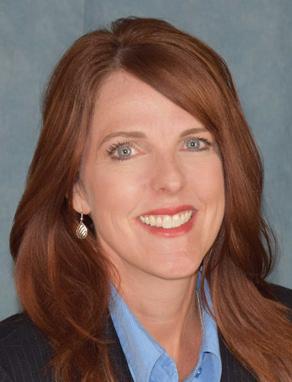
Governor’s Office of Economic Development
2017 Annual Report
www.business.utah.gov 17
•
•
Year Establishments Employment YearOver-Year Growth Average Annual Wages 2016 1,337 37,508 8 41% $66,437 2015 1,074 34,598 5 35% $66,411 2014 993 32,842 3 38% $62,561 2013 975 31,768 4 47% $58,988
Year Establishments Employment YearOver-Year Growth Average Annual Wages 2016 204 7,021 -1.89% $42,864 2015 198 7,156 4 16% $41,575 2014 190 6,870 2 48% $39,548 2013 181 6,704 1 73% $39,300
Year Establishments Employment YearOver-Year Growth Average Annual Wages 2016 4,494 73,697 5 34% $80,408 2015 4,201 69,963 5 63% $78,106 2014 3,823 66,232 4 95% $75,239 2013 3,797 63,106 3 16% $71,941
Grow & Support
Contact Ginger Chinn Managing Director 801-538-8850 gchinn@utah.gov
Economic Development Tax Increment Financing (EDTIF)
Purpose
U.C.A. 63N-2-1
The EDTIF program was created in statute to foster and develop key industry sectors in the state, to provide additional employment opportunity for Utah’s citizens and to improve the state’s economy The goals set forth in statute are to provide tax credits to attract new commercial business and new jobs to companies who are looking to expand existing business within the state or to relocate their business from another state; to provide a relationship between state and local economic development efforts; and to create a competitive advantage for the state .
Key Initiative
Calendar year 2015 is the most recent with fully vetted results to report In that year, there were 84 active EDTIF agreements . Contracts span from the program’s launch in 2004 up to the assessment year of 2015 Of those 84 active projects, 58 companies applied and received an assessment for tax credits for that calendar year

Most of the 84 projects can be categorized into GOED’s six strategic industry clusters and general manufacturing . Information technology companies represented 33 percent and is the largest segment of the companies that received an assessment

Outcomes
Jobs: Over the entire history of the program, GOED’s Compliance Team has verified the creation of 19,370 new full-time equivalent (FTE) jobs. The number of new jobs is a calculation of each company that had requested and completed an EDTIF assessment for the specific audit year. The calculation includes a count of employees for the audit period and then subtracts the baseline (the employee count from the time of board approval) for the first year. In subsequent years, the calculation includes the count of employees relative to the last reporting period, thus resulting in an increase or decrease from the time the company last reported For companies that did not have an assessment for an audit year, it is assumed for reporting purposes, there was

Governor’s Office of Economic Development • 2017 Annual Report • www.business.utah.gov 18
Grow & Support
no increase or decrease in the employee count These incremental increases or decreases each year can be added together to produce total increment job count
Revenue: Compliance receives a growing number of requests each year to calculate a company with an EDTIF award’s new state revenue New state revenue from paid and remitted employee withholdings, sales and use tax and corporate tax, which has increased from the time of board approval, is verified using information from the Utah State Tax Commission A percentage of these new state revenues can be rebated through the EDTIF program if the company meets the contractually defined number of high paying jobs for that period. The percentage of cumulative new state revenue and new state revenue for CY 2015 by type is in the following chart
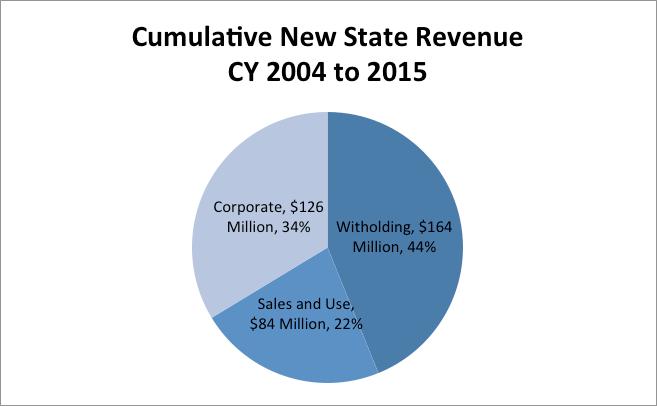
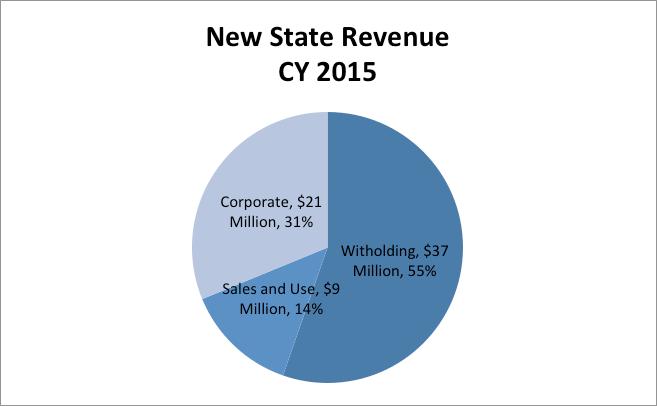
Over the history of the program EDTIF assessed companies have created $374.9 million in new state revenue and $262.6 million in new state revenue after tax rebates The difference in these two amounts represents tax credits that have been awarded by percentage of new state revenue incentivized, post-performance, by the EDTIF program The percentage of award has
been set in statue not to exceed 30 percent Recent contracts are trending towards terms of seven years and 20 percent As legacy contracts come to full term, we expect to see the margin between new state revenue and the amount of new state revenue after rebate to reduce and the amount of new state revenue retained by the state, after rebate, to increase
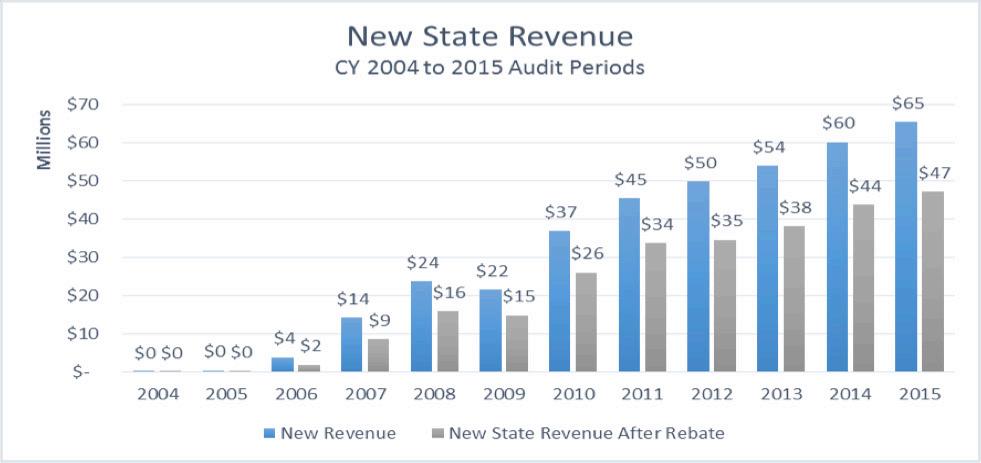
Challenges and Achievements
State government in Utah works best when agencies collaborate and the EDTIF program is no exception . The Department of Workforce Services (DWS) and the Utah State Tax Commission provides information that helps to validate new job creation and new state revenue We have benefited from program efficiencies resulting from increased collaboration this fiscal year and are excited to see additional future developments in The state’s incentive programs

Contact
Jim Grover Director of Compliance 801-538-8860 jimgrover@utah.gov
•
•
Governor’s Office of Economic Development
2017 Annual Report
www.business.utah.gov 19 Grow & Support
Enterprise Zone
Purpose
U.C.A. 63N-2-201
Businesses within an Enterprise Zone can claim state income tax credits for investing in plant and depreciable machinery and equipment; creating new, above average wage jobs; and the rehabilitation of older facilities GOED received full compliance oversight for this program from the State Legislature during the 2016 Legislative Session
Key Initiatives
The Office of Rural Development (ORD) conducted a thorough data cleanup of all program records The cleanup led to the re-discovery of current Enterprise Zone terms, county application deadlines and expirations, and shape file mapping verifications for locate utah gov All relevant and required supporting documentation was compiled into electronic file folders for easy location and verification. The Office of Rural Development worked with the GOED compliance team to set appropriate standards for reviewing and approving business applicants for Enterprise Zone Tax Credit certificates.
Challenges and Achievements
The Enterprise Zone is a cooperative program between GOED and rural counties and cities throughout the state. The goals in the next fiscal year include maintaining current Enterprise Zones where they have been established; keeping all internal records up to date, including mapping for locate utah gov; and encouraging communities to apply for the zone designation as an economic development tool
Data
ORD worked directly with the compliance team as they implemented processes and standards for vetting claims. Significant tax dollars were saved in comparison to prior year Enterprise Zone claims In previous years, as many as $14 million in Enterprise Zone tax credits may have been issued In contrast, tax credits certified in calendar year 2016 totaled approximately $4.6 million.
Enterprise Zone Tax Credits CY 2016
Number of projects: 422
Total credits: $4,634,000
Jobs created: 60
Private investment: $55,932,200

Governor’s Office of Economic Development • 2017 Annual Report • www.business.utah.gov 20
Outreach Specialist
Grow & Support
Contact James A. Dixon Rural
801-538-8687 jdixon@utah.gov
Targeted Business Tax Credit
Purpose
U.C.A. 63N-2-301
The purpose of the Targeted Business Tax Credit (TBTC) program is to encourage private investment and the creation of jobs in rural Utah counties with populations less than 25,000 As return on investment takes more time in remote rural economies than it does along the Wasatch Front, the TBTC encourages development in small rural counties
Key Initiatives
The Office of Rural Development worked with Rep. Becky Edwards and Sen Brian Shiozowa during the 2017 Legislative Session to update TBTC language (H B 416)
The updated TBTC application process creates competition for “shovel ready” projects that make significant capital investment and create jobs in rural counties with populations less than 25,000 When approved TBTC projects are complete, the additional TBTC tax credit application process will reduce inefficiencies in the system
Data
In CY 2016, GOED approved four applications and each were allocated the $100,000 cap. GOED will continue to report on future allocations as we implement H B 416
Challenges and Achievements
The statutory changes implemented in H B 416 gave GOED the authority to determine eligibility and issue TBTC certificates. The legislation also simplified a complicated calculation for TBTC eligibility by expanding eligible counties to include all those with populations less than 25,000

Contact
Linda Clark Gillmor Director 801-538-8804 lgillmor@utah.gov
Governor’s Office of Economic Development • 2017 Annual Report
www.business.utah.gov 21 Grow & Support
•
Recycling Zone
Purpose
U.C.A. 63N-2-401
The Recycling Market Development Zone (RMDZ) is established to encourage businesses to use renewable products and recycle materials that would otherwise go to landfills. Participating businesses receive tax credits on purchases of equipment used in the manufacturing or recycling of renewables
The RMDZ may be considered under-utilized as a business incentive and as a waste stream diversion In 2017, some cities and counties rediscovered the benefits of Recycling Zone tax credits for businesses involved in renewables manufacturing and recycling . They are re-applying for the zone area designation not only as an incentive to local businesses, but also as part of their waste management master plans
Key Initiatives
ORD also conducted a survey of companies who are regular users of the Recycling Zone tax credit The survey results were used to answer questions from the legislature about the program . The survey revealed that in one year, 164 jobs were created or retained, $6.5 million dollars in personal incomes at an average annual salary of approximately $40,000 were created or retained, and approximately 3 5 million tons of waste were diverted from Utah landfills at a cost-per-ton in tax credits of $0.38.
Challenges and Achievements
The RMDZ incentive was reviewed during the 2017 legislative session ORD assisted both the legislature and businesses with information on the RMDZ and metrics ORD encourages cities and counties to use the RMDZ tax credit as an economic development and recruitment tool, as well as a part of their waste management plans . ORD will continue to review renewal of RMDZ applications as they are submitted by cities and counties
At the beginning of FY 2017, the Office of Rural Development (ORD) organized and updated the information on past claims. This included a compilation of five years of claims, a report on the average numbers of claims per year, and the value of claimed tax credits Data Contact James
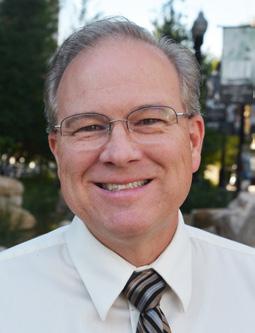
Governor’s Office of Economic Development • 2017 Annual Report • www.business.utah.gov 22
A. Dixon
Outreach Specialist
Rural
801-538-8687 jdixon@utah.gov
Grow & Support Recycling Market Development Zone CY 2015 CY 2016 Number of tax credits issued 19 10 Private capital investment: $36,067,200 $6,925,200 Total tax credits issued: $1,835,600 $358,800
New Market Tax Credits
Purpose
U.C.A. 63N-2-601
The Utah State Legislature enacted the Utah Small Business Jobs Act to attract additional investment in the most severely distressed areas of the state The act created a tax credit program more commonly referred to as the Utah New Market Tax Credit Program The program is a state corollary of the federal New Market Tax Credit Program and is designed to use $50 million raised by venture capital firms, designated by the IRS as Community Development Entities (CDE), to make investments into small businesses within distressed areas
A prospective CDE applies to the state to be authorized to raise their respective portion of the total $50 million. Once approved by the state, the CDE raises its authorized amount by issuing 58 percent income tax credits provided by the state to the investors who invest in each CDE’s respective funds The tax credits are funded through the premium tax collected on all insurance premiums in the state and are credit claimed against premium taxes owed to the state
Once each CDE has raised its authorized portion of the $50 million, it must invest 85 percent of the funds raised into eligible small businesses throughout the state with no one business receiving more than $4 million in investments. To be considered eligible a business must:
• Be located in a distressed or severely distressed census tract according to the 2010 census
• Fit the Small Business Association’s (SBA) definition of a small business
• Not derive more than 15 percent of its profits from the sale of real estate
Each CDE must invest the funds it raises within 12 months The investments are then monitored by the state for the next seven years to ensure compliance and track the success of each respective investment Additionally, the statute requires that each CDE reinvest portions of the interest or dividends earned from the investments made into additional qualified small business in the state. This will result in 150 percent of the original allocation amount awarded to each CDE being invested by the end of seven years
Advantage Capital, Enhanced Capital, and Stonehenge Capital each received authorization in 2014 to raise one-third of the $50 million total award. The three CDEs had until December 2015 to invest at least 85 percent of their respective funds (or $14.2 million) with a six month cure period if they do not meet this deadline Moreover, each CDE will be required to reinvest 50 percent more of this allocation amount (or an additional $8.3 million) into additional qualified small businesses by the end of the 7 year program
Please note that all reporting moving forward will be done on a calendar year (CY) basis rather than the state’s fiscal year due to statutory timelines and subsequent contractual timelines
As of the end of CY 2016, the three participating CDEs had made investments into 22 small businesses in Utah totaling $47,133,666.33. The CDEs reported the 22 small businesses created 313 new jobs in CY 2016. The office issued $6,000,000 in tax credits in CY 2016 pursuant to the statutory requirements
U.C.A. 63N-2-701
Alternative Energy Tax Credit Hotel Convention Tax Credit Purpose
As of FY 2017, no credits have been issued Purpose
U.C.A. 63N-2-501
As of FY 2017, no credits have been applied for or issued .
Life Science Tax Credit Purpose
U.C.A. 63N-2-801
There is no data to report beyond FY 2015
Governor’s Office of Economic Development
2017 Annual Report
www.business.utah.gov 23 Grow & Support
•
•
Procurement Technical Assistance Centers (PTAC)
Program Spotlight
In March 2017, Valor Magazine, a Utah Veterans Magazine, highlighted a successful Veteran Company, Veterans Trading Company (VTC) In the article, John Pearce, Vice-President for VTC, credits the Utah PTAC for its early success (From the Valor Magazine Article): Co-founder and Vice President of Business Development John Pierce says, “we’re very proud of our roots in Utah.” As a veteran-owned, HUB-zone certified business, VTC tapped into many of defense and economic connections in Utah, especially the Procurement Technical Assistance
Purpose
U.C.A. 63N-13-101
Procurement Technical Assistance Centers (PTAC) help small business successfully compete in the local and global government marketplace by providing knowledgeable and outstanding customer service
PTAC strives to be the premier resource in helping Utah small companies identify, pursue and win government contracts to grow their business PTAC regional managers offer one-on-one and group instruction (and many other services) at eight offices throughout the state.
Key Initiatives
PTAC Marketing Plan: PTAC began a major marketing campaign in November 2016 to raise awareness of its program and services to the small business community and the major stakeholders Armed with PTAC’s fact sheet and line cards, staff met with federal agencies, Department of Defense depots, congressional staff, chambers of commerce, business organizations, cities and counties, economic development directors throughout the state and tribal communities and associations
In all, over 40 organizations learned about the PTAC program, how to access our services and learned the value PTAC brings to Utah’s small business community
Center (PTAC) with the Governor’s Office of Economic Development (GOED) “They were a key player in our early years. Every veteran-owned small business should get to know this valuable resource.”

Contact
Chuck Spence PTAC Program Director 801-538-8655 cspence@utah.gov
PTAC Vendor Fair: The fair was held in October 2016 in Provo, UT, with opening remarks by Provo Mayor John Curtis There were over 47 booth exhibitors including federal, state and local agencies and prime defense contractors such as Orbital ATK, L-3 Communications and Boeing There were 310 attendees
Dugway Mission Installation Contracting & Command Industry Day: PTAC bussed 70 clients to Dugway Proving Grounds where small business clients met with 13 contracting officers and purchasing staff. Dugway officials discussed forecasted opportunities with PTAC clients This is one way PTAC provides valuable services to small businesses throughout Utah and creates economic opportunities
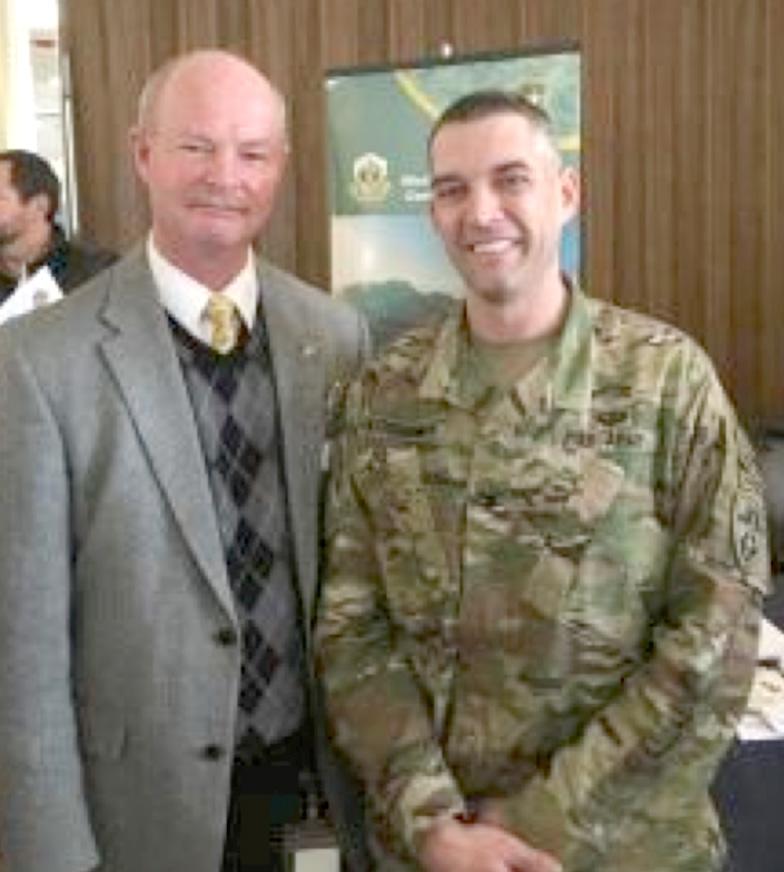
Utah Veterans Business Conference: Cosponsored by PTAC, the conference drew 173 veteran business owners and veterans interested in starting a business
Governor’s Office of Economic Development • 2017 Annual Report • www.business.utah.gov 24
Industry
Engage
Chuck Spence with Dugway’s former Commander, Sean Kirschner
Data
Challenges and Achievements
PTAC experienced one of our highest years for contracts awarded, at $421,824,718. PTAC also had a number of outstanding small business outreach events . Notably, two outreaches with Dugway Mission Installation Contracting & Command, several with Hill AFB, four with prime defense contractors including Boeing, Lockheed Martin, Siemens and Stadler PTAC clients also saw small dollar contracts awarded through the Army Air Force Exchange Commission (AAFEC) as a result of an outreach event
PTAC’s marketing efforts have raised awareness of this important business development tool and helped clients learn about how PTAC can assist them in responding to and winning government contracts
Governor’s Office of Economic Development • 2017 Annual Report • www.business.utah.gov 25 Engage Industry
FY 2017 Contracts Awarded 2,038 Amount of Contracts Awarded $421,824,718 Jobs Created/Retained 4,218 ($100K=1 job) New Clients Counseled (past 12 months) 610 New Clients Awarded Contract $16,309,700 Counseling Time (hours) 2,400 Events 60 FY 2016 Contracts Awarded 1,164 Amount of Contracts Awarded $221,259,128 Jobs Created/Retained 4,391 ($50K= 1 job) Counseling Time (hours) 1,979 Events 71 FY 2015 Contracts Awarded 1,450 Amount of Contracts Awarded $389,709,552 Jobs Created/Retained 7,755 ($50K= 1 job) Counseling Time (hours) 2,579 Events 75
Technology Commercialization & Innovation Program
Program Spotlight
Distal Access developed a game-changing device (RESECTR) for women’s health to remove uterine polyps “TCIP allowed us to internally justify keeping a long-term project in Utah despite the fact we knew we were likely to sell a technology to Boston Scientific…with TCIP money in hand, we convinced BSC that we needed to give a Utah-based entity the first shot. In November 2016, days before our sale to Boston Scientific was announced, we signed a long-term deal with Biomerics [a Utah company] to assemble the global RESECTR platform in Utah and transfer that agreement to Boston Scientific. TCIP gave the money and goodwill to keep this in Utah and incent an acquiring party to do the same This was a win for Boston Scientific, Biomerics, and us.
Purpose
U.C.A. 63N-3-201
The Technology Commercialization and Innovation Program (TCIP) creates positive economic impact in the state of Utah by assisting early stage companies commercialize their technology and take it to market .
TCIP supports the growth and commercialization of promising technologies developed by private sector entrepreneurs and by students and faculty of Utah’s higher education communities TCIP provides smaller, more frequent funding opportunities to a wide range of projects at critical points in their product life cycle
To be eligible for a TCIP grant, applicants must either be affiliated with a Utah-based university, or be a small business as defined by the U.S. Small Business Administration and whose principal place of business is Utah Applications are ranked according to:
“TCIP gave us support to create jobs, but companies can also use TCIP funds as an excuse to select a higher bidder if the bidder is in Utah and use the ‘bully pulpit’ with an acquirer to say, ‘I took TCIP funds, I have to keep this in Utah after you buy it or I’m not going to be welcomed back at TCIP ’
Shawn Fojtik, Founder & CEO, Distal Access

Contact
Clark Cahoon TCIP Fund Manager 801-538-8895 ccahoon@utah.gov
• Potential economic development in the state of Utah (number of jobs, average salary, etc .)
• Quality of management and leadership, including experience in startups or commercialization
• Strength of the company’s technology and potential for commercialization
• Size and growth of the market for the proposed technology
• Ability to sell and market the technology and credibility of their “go-to-market” strategy
• Strength of the company’s overall value proposition and competitive advantage
Mentorship and entrepreneurial curriculum are made available to award recipients as part of the grant program
Governor’s Office of Economic Development • 2017 Annual Report • www.business.utah.gov 26
Engage Industry
Key Initiatives
FY 2017 Solicitation: The 2017 solicitation cycle had an incredible amount of growth with 183 applications
Our diverse review committee was made up of over 40 academics, scientists, government officials, serial entrepreneurs, executives, business professionals, and legal experts We narrowed down the applications to 44 companies for in-person presentations, where we then reviewed and scored their performance . We took the top 20 companies and presented their projects to the GOED incentives subcommitee board for their recommendation of approval of funds. TCIP awarded $1.8 million to 20 companies for the FY 2017 cycle
Demo Day: Of our awarded 20 companies, 12 companies were able to participate in Demo Day held at the Impact Hub This was an exciting opportunity for these companies to showcase their product to the public and potential investors Companies highlighted their work and shared their go-to-market strategy with the goal to win more funding from private investors and venture capital firms. It was a well-attended event and participants felt it was a good value added activity from partnerships that GOED was able to leverage
Data
Challenges and Achievements
One challenge is finding the right review committee members who have the proper background, expertise and willingness to donate their time to review . In addition, it can be a challenge to market the program effectively across the state
TCIP received additional ongoing funding during the 2017 legislative session through BioUtah’s advocacy and the effectiveness of the program We have approximately $2.5 million in ongoing funding to distribute to companies and university teams to assist in the commercialization process
Moving forward, TCIP will make improvements to the contracting, invoicing and payment aspects so they’re more efficient and will integrate Salesforce with the help of GOED’s compliance and finance teams.
Governor’s Office of Economic Development • 2017 Annual Report • www.business.utah.gov 27 Engage Industry
Annual Incremental Revenue Cumulative Incremental Capital Raised Cumulative Incremental New FullTime Jobs Cumulative Incremental # of Customers/ Users Cumulative Incremental Payroll Cumulative Incremental # of Patents 2015 $544,223 $5,905,873 24 4,146 $1,502,196 14 2016 $25,529,339 $11,699,203 94 65,156 $5,446,617 12 2017 $1,721,187 $31,797,677 29 29,038 $2,934,007 12
licensing agreement
Distal Access
Solicitation Details (19 companies, $1.29 million in funding) 10- Life Science 5- IT/Software 3- Energy/Natural Resources 1- Aerospace & Defense 2016 Solicitation Details (24 companies, $2.4 million in funding) 14- Life Science 7- IT/Software 2- Energy/Natural Resources 1- Outdoor Recreation 2017 Solicitation Details (20 companies, $1.7 million in funding) 7- Life Science 6- IT/Software 3- Energy/Natural Resouces 3- Aerospace & Defense 1- Outdoor Recreation
All numbers are self-reported by companies *incremental revenue in 2016 reflects a large
signed by
2015
Business Resource Centers
Program Spotlight
Harvest Lane Honey utilized the services of Toole BRC and SBDC this past year Founders Mike and Rhonda Wells and Jason and Mindy Waite first started keeping bees to pollinate their own gardens The hobby soon produced one-of-a-kind beekeeping equipment. After attending several trainings and learning how to start and grow a business, the friends launched Harvest Lane Honey The Harvest Lane Kit and other products are now available through several establishments including Home Depot and Amazon. What started with one full-time em-
Purpose
U.C.A. 63N-3-301
Business Resource Centers (BRCs) are convenient “onestop-shops” to address the needs of new or growing businesses. Through on-site or over-the-phone assessments with clients, BRCs offer comprehensive services and ongoing assistance to help businesses expand
Formed in partnership with local colleges or universities, BRCs house various business service providers in a single location and the onsite staff is equipped to answer questions ranging from business planning to finding funding and more. BRC staffs coordinate the resources of local business service provider partners to make the delivery of solutions more effective for the business customer
BRCs are tailored to the local community they serve and have service providers who are experts in their fields. Some of the partners found at the BRCs include the Small Business Development Center (SBDC), which is sponsored by the U S Small Business Administration; Procurement Technical Assistance Centers (PTAC), which provide governmental contracting assistance; Manufacturers Extension Partnership (MEP); Service Corps of Retired Executives (SCORE); and
ployee in a garage has grown to 11 full time and 2 part time employees in a 20,000 sq ft production space As they look to the future, Harvest Lane Honey is hoping to expand into international markets
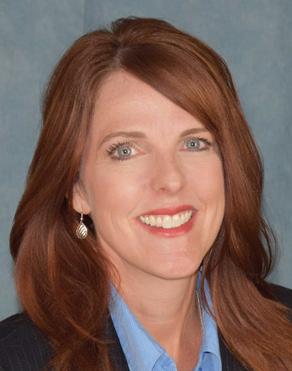
Contact
Ginger Chinn Managing Director 801-538-8850 gchinn@utah.gov
the Utah Science Technology and Research (USTAR) initiative . In addition, investors, microloan organizations, business incubators, chambers of commerce, local economic development organizations and resources are available at the local educational sponsor Because BRCs are interconnected statewide, directors can access fellow centers to find a solution for a specific business.
Key Initiatives
In addition to the day-to-day counseling with business owners and connecting them with service providers,

Governor’s Office of Economic Development • 2017 Annual Report • www.business.utah.gov 28
The San Juan BRC in Blanding
Engage Industry
BRCs across Utah pursued interesting projects in FY 2017:
• Uintah Basin BRC in Vernal brought together many community/partner events during the last fiscal year including the Duchesne County Women’s Business Conference, which had 87 women in attendance
• San Juan BRC created a Business Resource Room and a training/interview/computer room, which was set up for any business owner, or anyone looking to start a business, to use for free
• Dixie BRC was recently recognized by the U S Small Business Administration for their contributions to the local economy through their support of Design to Print Owners Stefanie and Joshua Bevans were named the 2017 Utah Small Business Persons of the Year The St George Small Business Development Center plays a key role in the economic growth of
Data
Southern Utah by helping small businesses reach their goals of expansion, innovation, productivity and management improvement
• Wasatch BRC participated in numerous outreach and networking events One such success was when they combined with Ogden SBDC and Startup Ogden to bring in clients such as the Kauffman Foundation’s 1 Million Cups program, which meets each month
• Box Elder BRC hosts mastermind meetings, with the most successful being their client appreciation party with 60 in attendance
• Cache BRC has had meaningful interactions and support with their clients that have furthered them in their process for creating or growing their businesses Communities have reached out to them to help provide training for their businesses
In FY 2017 the cumulative reporting results of our 15 different BRCs throughout Utah:
Governor’s Office of Economic Development
2017 Annual Report
www.business.utah.gov 29 Engage Industry
•
•
Reporting BRCs Unique Contacts Total Incubator Clients New Incubator Clients Start-ups Classes Facilitated Class Attendants 15 2,944 218 202 251 237 16,251
Rural Fast Track
Program Spotlight
Often times, odds seem stacked against a business operating in a limited market The Rural Fast Track incentive is a valuable tool to help these businesses expand
“This is one of the best tools in rural Utah to spur investment and economic development The simple yet effective art of identifying those businesses who are ready and eager to expand is enhanced when the state becomes a catalyst Rural Fast Track has become an effective program that has helped many projects come to fruition
Finally a rural incentive that really works and helps businesses to expand one job at a time One job in rural Utah is so valuable and can easily be compared to bringing 50 new jobs to an urban area Rural Fast Track is changing
Purpose
U.C.A. 63N-4-101
The Rural Fast Track (RFT) program supports small companies in rural Utah by awarding post-performance grants for job growth and expansion RFT’s key objective is to identify and support businesses throughout rural Utah that are eligible to utilize RFT funds Working with county economic development directors—our “boots on the ground”—businesses complete a rigorous application process and submit projects that are then analyzed for program adherence After meeting all requirements and receiving approval from the Governor’s Rural Partnership Board and GOED Board, the contract is produced Once the project is completed, reimbursement is coordinated with the Office of Rural Development (ORD) and the compliance team
Data
the outlook for rural Utah one job at a time.”
— Irene Hansen, Economic Development Director for Duchesne County Contact

Nan Groves Anderson
Rural Outreach Specialist
435-287-4170
nanderson@utah.gov
Key Initiatives
ORD has initiated modification of the entire RFT process (application, submission of information and documentation) using a more efficient and streamlined method in SalesForce SalesForce integration will allow for creation of reports, charts, graphs and up-to-the minute data on a company’s full interaction with GOED programs
Challenges and Achievements
RFT is working with the Legislature to establish the best funding practices to ensure the program’s lasting impact in rural Utah Moving forward, RFT will enact new marketing strategies to increase awareness of successes In addition, the program will continue working with GOED Compliance to streamline processes via SalesForce
Governor’s Office of Economic Development • 2017 Annual Report • www.business.utah.gov 30
RFT Funds Awarded Fiscal Year Projects Completed Incentive Amount Paid Jobs Created Private Investment $Private/$Public FY 2015 22 $ 977,958.31 19 $ 6,732,240.97 6 88 FY 2016 22 $ 874,168.01 22 $ 2,648,603.32 3 03 FY 2017 20 $ 838,628.45 23 $ 3,737,852.00 4 46 Engage Industry
Business Expansion and Retention (BEAR)
Purpose
U.C.A. 63N-4-101
The Business Expansion and Retention (BEAR) grant was issued to 25 rural counties throughout the state in FY 2017 . The BEAR grant extends funding to county economic development leaders as they reach out to individual businesses They assess the needs of the businesses and address their goals, and then direct them to useful resources to help them thrive and grow in rural communities. In addition to face-to-face business visits, BEAR funds are used for economic development opportunities within counties such as area sector business analyses (economic development planning) and implementation of planning outcomes BEAR funds can also be used for specialized business training to individuals, business teams and business owners
Key Initiatives
The Office of Rural Development (ORD) laid out a plan for internal review for the BEAR Program to be completed prior to the next legislative session This was initiated in response to some of the challenges incurred while administering this year’s program The review provided insight into how the program was being used and how to make it more effective moving forward
Challenges and Achievements
The internal review of the BEAR program identified three main challenges
• Funding for the BEAR program is outlined in statute as 4 percent of the unencumbered balance within the Industrial Assistance Fund (IAF) As the IAF balance is reduced, funding to the BEAR program is affected
• While new compliance standards have led to overall improvements in program quality, they have also created new challenges in timely payments
• Executive Pulse, the customer relationship management (CRM) and reporting system did not meet the needs of the grant recipients ORD is in the process of reviewing and identifying a new, more effective CRM
Data
Approximately $234,000 from the Industrial Assistance Fund was expended by the 25 counties participating in the BEAR program . A number of contracts were amended throughout the year to allow for project-based opportunities. Changes are reflected in a reduction in traditional Business Expansion and Retention activities over the last three years .
Comparable BEAR
Targeted funding toward project-based uses of BEAR funds led to the creation of new economic development studies to identify opportunities, more community-driven planning and implementation, and more business training seminars and summits
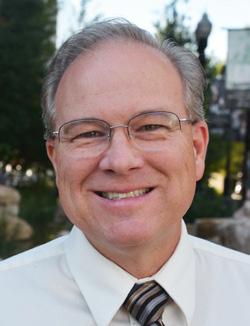
Governor’s Office of Economic Development • 2017 Annual Report • www.business.utah.gov 31
Program Outcomes FY 2015 FY 2016 FY 2017 BEAR visits/surveys 3600 2297 1689 Action items 1970 1220 1015 Hours spent 3283 1969 1194 Estimated jobs created 882 206 337 Estimated jobs retained 261 113 102
BEAR Program Outcomes FY 2017 Businesses receiving CONSULTATION: 26 Businesses participating in specialized BUSINESS TRAINING: 177 Individuals participating in SEMINARS or SUMMITS: 1185 Community-driven PLANNING & IMPLEMENTATION: 19 Engage Industry
James A. Dixon Rural Outreach Specialist 801-538-8687 jdixon@utah.gov
Contact
Utah Office of Tourism
Program Spotlight
From 2013 to 2023, visitors are expected to spend nearly $2.5 billion to experience the dark skies over the Colorado Plateau, generating more than 50,000 incremental jobs (Source: Missouri State University). Of the 50 accredited or in-process International Dark Sky Parks and Communities constituting the greatest concentration of the finest dark skies in the developed world (The Great Western Starry Way), fully half are in Utah
Thanks to highly scenic public lands and extraordinarily low humidity, Utah is the single state with the best night sky viewing opportunities, offering the marvels of the Milky Way to both locals and tourists from around the world
This means big dollars You can drive through Zion National Park, but experiencing dark skies generally means an overnight stay with at least two meals This economic leverage extends across all seasons and shifts travelers to off-peak hours.
Dark skies also facilitate short-term and long-term job growth while protecting human health, wildlife abundance, community character and cultural legacy Dark skies are, moreover, a key driver in the rural transition to tourism-based economies.
Purpose
U.C.A. 63N-7
The mission of the Utah Office of Tourism (UOT) is to promote tourism to out-of-state travelers and support tourism-based economic development. In addition, UOT works to continually improve the visitor experience and the state’s overall quality of life To advance these goals, the agency runs year-round marketing, public relations and travel trade programs to inspire domestic and international travelers to visit Utah and provide key inspiration on arrival in market They also engage the front line of hospitality in the agency’s vision to encourage a high standard of customer service
In 2013, Gov Herbert established a goal to increase travel-related tax revenues from $1.09 billion to $1.2 billion by 2020 In 2016, Utah achieved this goal as travelers spent $8.4 billion, generating $1.2 billion in state and local tax revenue, which in turn supported 144,187 jobs statewide and $5.6 billion in wages.
The UOT team is completely keyed into the momentum, effectively leveraging the science and culture of dark skies in travel promotions through strategic messaging with visiting journalists and at high-profile events. On the digital side, UOT helped assemble a dark-skies marketing toolkit and supported content development for VisitUtah com
It’s been quite a year for dark sky promotion in the state of Utah, with growing recognition of Utah’s economic advantages from a newly prominent and unmatched natural resource
— Janet Muir, Co-Founder, Consortium for Dark Skies Studies (University of Utah) Contact
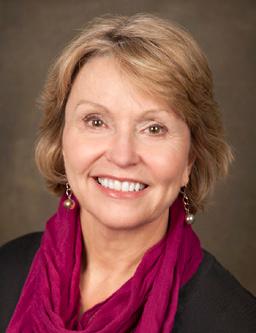
Vicki Varela
Managing Director
801-538-3395
vvarela@utah.gov
Looking ahead, UOT is creating a long-term, responsible tourism strategy that attracts the right tourist to the right destination with the right preparation The strategy will also get travelers off the beaten path to regions that want and need visitation Meanwhile, UOT will build from its SUCCESS framework that tracks engaged website visitors as a proxy for travel intent
Key Initiatives
Marketing: Two major integrated marketing campaigns provided the structure for UOT’s FY 2017 marketing strategy. A $5.78-million, three-season campaign included national advertising of The Mighty 5® and The Road to Mighty®. An expanded year-round digital content marketing effort supported these campaigns
UOT’s $3.37-million winter media buy highlighted year three of the Find Your Greatest® campaign
Co-op Marketing: The Board of Tourism Development awarded $3.4 million in 1:1 matching funds as part of its
Governor’s Office of Economic Development • 2017 Annual Report • www.business.utah.gov 32
Expand the Experience
FY 2017 $4.2 million cooperative marketing appropriation Rural counties received 46 percent of the awards The remaining $800,000 was distributed through UOT’s opt-in format of domestic and international marketing options and UOT’s Rourism (rural tourism) initiative
FAM Tours: UOT’s travel trade team hosted 43 familiarization tours (FAMs) from 10 markets for a total of 186 international guests including media and tour operators . Top annual trade shows included IPW, World Travel Market in London, ITB in Berlin and Go West Summit
Data
The domestic PR team leveraged multiple familiarization tours and proactive, targeted story pitching into 166 articles, of which 65 were on UOT’s top 100 publications list
Tourism Day: Utah Tourism Industry Association and UOT hosted the 11th Annual Tourism Day on the Hill and the Utah Tourism Conference The conference achieved record attendance, drawing more than 400 industry partners
In FY 2017, UOT worked with consultants of the Governor’s Office of Management and Budget to establish its SUCCESS framework UOT evaluates website analytics to determine engagement The benchmarks for achievement are visits that exceed four minutes time on site or that viewed greater than three pages 0k
80k
70k
60k
50k
40k
30k
20k
10k

Governor’s Office of Economic Development
2017 Annual Report
www.business.utah.gov 33
•
•
Jan
2015
Apr
2015
Jul
2015
Oct
2015
Jan
2016
Apr
2016
Jul
2016
Oct
2016
Jan
2017
Apr
2017
#
of
Visits
Dura-on
of
Goal
Measurement
VisitUtah.com
Goal
Achievements
How
many
visits
included
3+
site
pages
OR
lasted
4+
minutes
each
month
$2.1
mm
$10.5
mm
mm
mm
FY2015
FY2016
FY2017
Marke8ng
Sports
Commission
$1.5
mm
$1.8
mm
$12.6
$14.7
$0.0
mm
$5.0
mm
$10.0
mm
$15.0
mm
$20.0
mm
$25.0
mm
Tourism
Marke-ng
and
Performance
Fund
(TMPF)
Co-‐op
(20%)
(10%)
Adver8sing
(70%)
Expand the Experience





Challenges and Achievements
U S Travel Association named Vicki Varela State Tourism Director of the Year and Hospitality Sales and Marketing Association International (HSMAI) recognized Varela as a Top 25 Extraordinary Mind in the industry HSMAI awarded UOT a Gold Adrian for its website strategy and U .S . Travel recognized UOT’s travel guide with a Mercury Award
Crowded conditions or visitor capacity restrictions at Utah’s national parks lead the factors that could limit future growth and affect the quality of life for Utahns At Zion National Park, for example, visitation has increased more than 50 percent since 2010 while funding allocated by Congress for park operations has decreased by just over 5 percent .
Governor’s Office of Economic Development • 2017 Annual Report • www.business.utah.gov 34 Expand the Experience
19.9%
17.4%
5.9%
5.3%
5.3%
3.9%
0.0%
5.0%
10.0%
15.0%
20.0%
25.0%
Canada
China
France
United
Kingdom
Germany
Australia
Top
6
Markets:
Es/mated
Spending
as
Percentage
of
Total
Int'l
Spending
CY2016
CY2015
CY2014
$591.5
mm
$198.2
mm
$1,956.6
mm
$246.0
mm
$1,482.4
mm
$311.5
mm
$47.0
mm
$15.8
mm
$155.6
mm
$19.6
mm
$117.9
mm
$24.8
mm
$0.0
mm
$500.0
mm
$1,000.0
mm
$1,500.0
mm
$2,000.0
mm
$2,500.0
mm
3-‐Season
2014
Winter
2014-‐15
3-‐Season
2015
Winter
2015-‐16
3-‐Season
2016
Winter
2016-‐17
Adver&sing
Campaign
Effec&veness
Economic
Impact
State
and
Local
Tax
Revenue
$7,982.0
mm
$8,168.5
mm
$8,402.0
mm
$1,097.4
mm
$1,150.4
mm
$1,226.6
mm
$0.0
mm
$1,000.0
mm
$2,000.0
mm
mm
mm
mm
mm
mm
mm
CY2016
$3,000.0
$4,000.0
$5,000.0
$6,000.0
$7,000.0
$8,000.0
mm
$9,000.0
CY2014
CY2015
Utah's
Travel-‐Related
Economy
Total
Travel-‐Related
Spending
Total
Travel-‐Related
Tax
Revenues
Utah Film Commission
Program Spotlight
In September of last year, Disney Channel began filming its new television series, Andi Mack, in Utah This is the latest of Disney productions to shoot in Utah Over the last 20 years, Disney has brought 39 productions to Utah, including Pirates of the Caribbean: At World’s End, The Lone Ranger and all three High School Musical films, but a network series is a first.
The show aired this past spring, collecting nearly 40 million views, and is currently ranked as the No 1 show for girls aged 6-14. Further reason to celebrate came with the announcement of a second season approved to shoot in Utah, with more than 200 local cast and crew expected to be employed and an in-state spend of approximately $18 million.
Purpose
U.C.A. 63N-8-101
The Utah Film Commission was established in 1974 to support the rich legacy of filmmaking across the state. Promoting the use of professional and experienced local crew, talent, support services and locations, the Film Commission markets Utah as a destination for award-winning content creation. With almost 1,000 films created in state, Utah has a deep and lasting commitment to the entertainment industry
The Utah Film Commission is a catalyst for the growth and evolution of the state’s diverse economy through our creative industries. The film industry’s contribution to Utah’s economy is evident: 450 companies, over 4,700 employees and more than $110 million in Utah salaries.

Michelle Manning, executive producer of Disney Channel’s Andi Mack, said, “I have shot all over the world, but Utah is now my favorite place to film. This show has a special place in my heart and in season one, the cast and crew bond was like nothing I have ever experienced It’s been a case of home-away-from-home for us, and we’re eager to begin filming season two in and around Salt Lake City.”
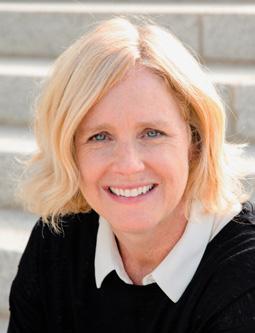
Key Initiatives
Contact
Virginia Pearce
Utah Film Commission Director 801-538-8740 vpearce@utah.gov
Sundance Film Festival: The 2017 festival premiered four made-in-Utah productions – more than ever before – allowing Utah to be showcased to the global film industry.
Film Day on the Hill: Each year the Film Commission takes the opportunity to educate stakeholders on the importance of film in Utah. This past year, it was a great success with over 30 companies and organizations representing Utah’s thriving film and digital media industry in education, production, exhibition and emerging media
Strategic Plan: The Kem C Gardner Policy Institute was commissioned to produce a detailed study of Utah’s film and digital entertainment industry and resulted in a new strategic plan for the future
Community Film Incentive Program (CFIP): The program was established as part of the longstanding Motion Picture Incentive Program, to support smallerbudget productions and encourage up-and-coming, Utah-based talent to remain in state. Six productions were approved in FY 2017 under the CFIP, supporting local directors and producers
Governor’s Office of Economic Development • 2017 Annual Report • www.business.utah.gov 35
Westworld on location at Dead Horse Point State Park
the Experience
Photo by HBO Expand
Data
Thirty-one productions were approved under the Motion Picture Incentive Program in FY 2017, including Disney Channel’s Andi Mack, HBO’s Westworld and a modern remake of Little Women. An estimated $64 million was spent in state, with more than 2,400 local jobs created
The number of reported film permits across the state almost doubled in from 2016 to 2017 from 356 to 602 permits, of which 69 percent were issued in a rural area
Produc:on
Analysis
70
60
50
40
30
20
Television series are incredibly valuable for Utah and there are now two major networks filming series here as well as two additional smaller network series These shows create full-time, year-round employment for local crew and have the potential for long-term com0
500
1000
1500
2000
2500
3000
** FY 2017 contains estimates as some projects are not completed yet
Challenges and Achievements
Because of this increased interest in Utah’s locations, resources and crew, the Utah Film Commission has committed all of the FY 2018 funds as of September 2017 This creates a challenge for us to continue marketing the state as a place to locate incoming productions
Governor’s Office of Economic Development
2017 Annual Report
www.business.utah.gov 36 Expand the Experience
•
•
FY
2015
(24
Projects)
FY2016
(18
Projects)
FY2017
(31
Projects)**
Total
Utah
Produc:ons
Days
Total
Utah
Hires
Million
Million
0
10
Million
Million
Million
Million
Million
Million
FY
2015
FY2016
1FY2017**
Total
Utah
Spend
Total
Spent
in
Rural
Utah
Total
IncenCves
Board
Approved
mitment to the state
Economic
Impact
Utah Office of Outdoor Recreation
Program Spotlight
The National Ability Center (NAC), a Utah Outdoor Recreation Grant recipient, unveiled its newly renovated adaptive ropes challenge course in June The NAC’s core mission is to empower individuals of all abilities through sport, recreation and educational programs It is a national leader in providing sports and recreational opportunities for individuals with disabilities NAC has more than 28,000 programming experiences at their facilities in Park City used by differently abled individuals, youth and even military More than 37 percent of those who use the course come from outside Utah, including international groups Of the remaining 63 percent, 40 percent of those come from over 40 miles away and also use lodging in Park City, boosting the local economy
“It is humbling to be a part of an organization that is among the best at providing recreation opportunities
Purpose
U.C.A. 63N-9
The Office of Outdoor Recreation (OOR) embodies the state’s ongoing commitment to outdoor recreation as both an economic driver and a way of life OOR’s guiding vision is to ensure that all Utahns can live a healthy, active life through outdoor recreation. The office supports this vision through the following objectives:
• Grow funding for the Utah Outdoor Recreation Grant to increase recreation infrastructure statewide
• Attract outdoor recreation businesses to Utah to develop the industry
• Increase awareness of best practices and OOR resources through media, events and tours
• Support state programs related to outdoor recreation, such as the Utah Search and Rescue Assistance card
OOR’s foremost strategy for meeting these objectives is collaboration Working closely with the Legislature, the office secured increased funding for grant programs to
to people of all abilities,” said National Ability Center Board President Michael Kerby “Special thanks are owed to the Utah Office of Outdoor Recreation, Governor’s Office of Economic Development (GOED) and Intermountain Healthcare for making our vision of continuously improving and better serving our individuals and families a reality.”

Contact
Tom Adams Director
801-244-3869
tomadams@utah.gov
create more recreation infrastructure In partnership with EDCUtah, OOR assists with corporate recruitment efforts to boost Utah’s outdoor industry OOR will continue to promote Utah as the top state for the outdoor products and recreation opportunities that enhance quality of life

Governor’s Office of Economic Development
2017 Annual Report
www.business.utah.gov 37
•
•
Expand the Experience
Key Initiatives
Utah Outdoor Recreation Grant: OOR successfully completed its second round of awards and provided funds for 31 projects statewide . As total grant requests increased by 300 percent, OOR sought increased funding. H.B. 264 increased grant funding from $1 million to $4.2 million annually for five years, dependent on transient tax revenue The program has supported infrastructure projects and youth programs statewide .
Utah Outdoor Recreation Summit: Recognizing the unique needs of different regions, OOR took the summits on the road, hosting three summits in Ogden, Cedar City and Moab This model helped each summit focus on local challenges and applicable best practices for every corner of the state
Utah Search and Rescue Assistance (USARA) card: In partnership with the Utah Department of Emergency Management, OOR launched USARA, a program that provides backcountry recreationists peace of mind Participants purchase a subscription to ensure their free access to search and rescue services. With $20,000 in sales the first month alone, OOR seeks to sell $100,000 in cards by the end of year one
Media strategy: OOR has increased awareness of the state’s outdoor industry and programs through a total of 80 media opportunities: 29 presentations, 15 TV and radio interviews, and 36 news articles OOR launched an Instagram account that has attracted over 1,000 followers and significant post engagement.
Challenges and Achievements
In FY 2017, the demand to funding ratio for the Utah Outdoor Recreation Grant was 13:1 This prevented the funding of several projects throughout the state . With help from the Legislature, H.B. 264 will significantly increase funding and ensure more projects come to fruition
On the corporate recruitment front, there is a significant challenge presented by the size of most outdoor companies OOR will continue to partner with the State Legislature to ensure the long-term support of Utah’s outdoor industry and recreation infrastructure
Data
Utah’s outdoor economy continues to grow This year saw the attraction of several new companies to the state, including Big Agnes, Rotor, Wild Tribute, Fischer Skis and Shred On the mergers and acquisitions front, Vista Outdoor officially opened its world headquarters in Farmington and now represents 50 brands
The Utah Outdoor Recreation Grant provided funds in 14 counties, with a 6:1 ratio of private funding vs . state funding in these projects, demonstrating significant overall capital investment in communities


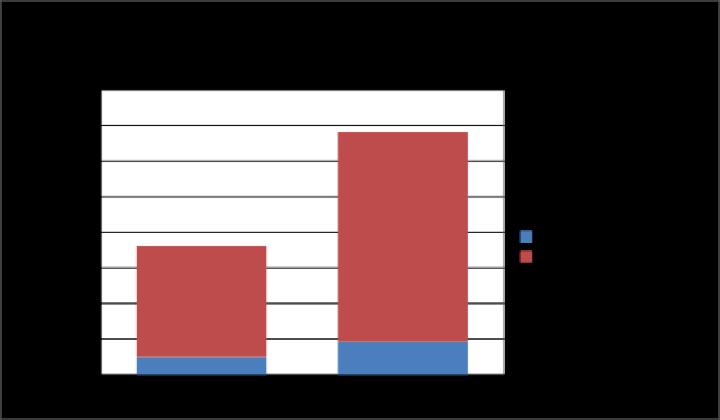
Governor’s Office of Economic Development • 2017 Annual Report • www.business.utah.gov 38 Expand the Experience
tgoetz@utah.gov Advance
Utah STEM Action Center
Program Spotlight
After receiving a High School STEM Industry Certification grant from the Utah STEM Action Center, Nebo School District is implementing a “Student Teaching Students” model and has seen great success with 80 high school students teaching 900 fifth grade student coding this past school year Nebo School District implemented the “Students Teaching Students” model by creating a STEM Ambassadors Program where high school students taking Exploring Computer Science classes were chosen by their teachers to visit elementary schools near them and teach coding
Purpose
U.C.A. 63N-12-201
The STEM (science, technology, engineering and math) Action Center prioritizes STEM education, with a focus on supporting Utah’s workforce of the future
The program drives research and implementation of STEM education best practices across Utah by coordinating STEMrelated activities, helping to create and support STEM education, facilitating educator access to education tools, connecting education with industry and aligning public STEM education with higher-education STEM activities. In order to advance STEM initiatives, the STEM Action Center Board will use legislative funding to oversee several projects that align with K-16 education, support the Utah State Board of Education and K-12 education and higher education partners
These programs address issues that support outreach, recruitment, advocacy, retention and student achievement Additionally, the STEM Action Center will align technology and innovation with industry needs and higher education initiatives to ensure development of the future workforce
This will be a safeguard to the state’s economic prosperity by ensuring there is a workforce ready to take on the high-quality and high-paying STEM related careers.
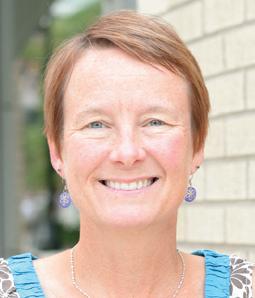
Key Initiatives
Contact
Tamara Goetz, Ph.D. Executive Director 801-538-8867
The following projects are part of the STEM Action Center’s portfolio, in partnership with the Utah State Office of Education, the Utah System of Higher Education, local education leaders and industry:
• Providing innovative approaches to professional learning for K-12 educators
• Creating an elementary STEM endorsement
• Coordinating a K-16 Computing Initiative grant
• Supporting Career and Technical Education programs
• Deploying personalized learning math tools in K-12 classrooms
• Implementing a standardized STEM School Designation certification for schools
• Helping educators and students engage with STEM subjects through hands-on activities
• Increasing access to STEM education and careers with the Utah STEM Bus mobile classroom
• The STEM Action Center provides several micro-grant opportunities that support student participation in STEM activities and support teachers in the classroom: – Classroom grants provide funding to support new STEM activities for teachers and
– Organizations grants that host activities such as robotics and science fairs
• Numerous events were sponsored that included SheTech (a girls tech day hosted by industry) and STEMFest and outreach events, along with various award events that recognized student achievement in STEM
Governor’s Office of Economic Development • 2017 Annual Report • www.business.utah.gov 39
Partnerships
Data
Classroom grants impacted nearly 16,000 students, and organization grants impacted nearly 65,000 students
The following graph illustrates the impact of sponsorships over the past three years of operation

Challenges and Achievements
The goals of the STEM Action Center are to continue to expand awareness and access to STEM education and career pathways The center will work with all stakeholders to secure resources to create a rich, engaging 21st century learning environment for students. The K-16 Computing Initiative and Utah STEM Bus illustrate the collaborative approach that the center employs to leverage commitment and resources to impact student opportunity and success

Governor’s Office of Economic Development • 2017 Annual Report • www.business.utah.gov 40 Advance Partnerships
Advance Partnerships
Utah Broadband Outreach Center
Program Spotlight
On a national level, the Federal Communications Commission has formed the Broadband Deployment Advisory Committee, which is tasked with drafting model codes of broadband-friendly practices for municipalities and states, evaluating competitive access issues, analyzing state and local barriers to deployment and providing recommendations to streamline federal siting for broadband Kelleigh Cole, the program director was recently named as the vice chair of the committee
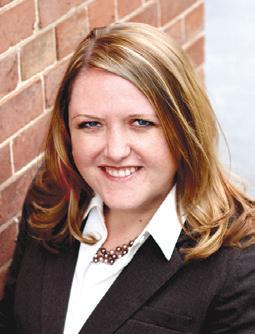
Purpose
U.C.A. 63N-12-301
The Utah Broadband Outreach Center is a state program focused on working with private sector broadband providers and other relevant stakeholders to encourage the voluntary expansion of broadband networks to support economic development in both urban and rural Utah The outreach center also convenes the Utah Broadband Advisory Council, which provides the governor and Legislature with policy guidance and recommendations

Since the I-15 Reconstruction Project surrounding the 2002 Olympics, UDOT has woven broadband into rights-of-way along state roads. The Center promotes similar infrastructure projects statewide.
Key Initiatives
Contact
Kelleigh Cole Program Director
801-538-8831
kcole@utah.gov
Locate.Utah.gov: During FY 2017, the Utah Broadband Outreach Center merged locate utah gov (Utah’s Economic Development Map) with the Economic Development Corporation of Utah’s SureSites (a directory of project-ready commercial real estate). Locate. utah .gov supports corporate recruitment and business expansion efforts by featuring utility availability, transportation resources and outdoor recreation opportunities Merging with SureSites, the tool will now allow companies relocating and expanding in Utah to search key corporate real estate listings . Locate .utah .gov won an Excellence in Economic Development Award from the International Economic Development Council for being a key tool in coordinating public and private collaboration
Policy Coordination: The Outreach Center is tasked by statute to coordinate broadband development policy and promotion among broadband providers, state and federal agencies and local government entities Over the past year, the center worked with Sen Orrin Hatch’s office and several Utah stakeholders to provide input on the Rights-of-Way Permitting Efficiency Act of 2017. Over the past several years, broadband providers have expressed concerns that federal permitting timelines have impacted their ability to do business, and this bill would help speed up that process It was introduced into the U S Senate on March 10, 2017
Governor’s Office of Economic Development
2017 Annual Report
www.business.utah.gov 41
•
•
Data
The Utah Broadband Outreach Center is charged in statute with working with partners to share best practices to improve broadband services In 2017, the center worked with the following groups:
The center’s website houses an active blog with policy and news information, along with both residential and commercial broadband maps
demonstrates that Utah’s citizens are actively using this information These
The following industry-reported statistics show the status of broadband development throughout Utah over the past several years
Challenges and Achievements
Although Utah is leading the way in broadband connectivity, there is still a lot of work to be done as consumer and business demands increase Keeping up with the rapid pace will involve collaboration between government, broadband providers, businesses and communities Helping Utah’s cities and towns work with
providers to develop best practices will be key to reducing deployment costs and creating a business-friendly environment . Because the center tracks broadband access every six months, speeds and coverage areas are continuing to increase
Governor’s Office of Economic Development • 2017 Annual Report • www.business.utah.gov 42 Advance Partnerships
Organization Type Request Type 2017 Requests 2016 Requests Private Businesses Service Upgrades 9 11 Broadband Providers Data, Government Coordination 6 10 Cities Planning Support, Service Upgrades 20 9 Counties Planning Support, Service Upgrades 9 5 Federal Agencies Policy Guidance, Data 4 State Agencies Policy Guidance, Data 7 AOGs/Special Service Districts Planning 8 Non-Profits Policy Guidance, Data 9 U.S. Senate Offices Policy Guidance, Data 3 Total 75 35
Usage
are derived
and
interactive maps and may represent
users
Sessions Users Pageviews New Users July 1, 2016-June 30, 2017 22,570 15,836 36,502 69 06 July 1, 2015-June 30, 2016 18,561 11,942 31,970 63 59 July 1, 2014-June 30, 2015 16,930 10,980 33,129 61 61
data
statistics
by adding the statistics from the broadband website
its
repeat
to the site .
Fall 2013 Fall 2014 Fall 2015 Fall 2016 Unserved 0 41% 0 16% 0 13% 0 14% 768 Kbps - 1.5 Mbps 0 09% 0 01% 0 01% 0 01% 1.5 Mbps - 3 Mbps 0 32% 0 18% 0 05% 0 04% 3 Mbps - 6 Mbps 0 38% 0 48% 0 44% 0 40% 6 Mbps - 10 Mbps 0 28% 0 06% 0 05% 0 04% 10 Mbps - 25 Mbps 9 32% 8 62% 6 97% 4 21% 25 Mbps - 50 Mbps 2 73% 2 64% 1 49% 4 34% 50 Mbps - 100 Mbps 5 49% 11 00% 3 28% 2 08% 100 Mbps - 1000 Mbps 72 53% 66 89% 73 18% 65 28% 1000+ Mbps 8 46% 9 96% 14 41% 23 68%
Pete Suazo Athletic Commission
Purpose
U.C.A. 63N-10
The mission of the Pete Suazo Utah Athletic Commission (PSUAC) is to provide a safe, healthy environment for combat sports in the state of Utah . The commission will fulfill this purpose by establishing and maintaining administrative rules that effectively govern combat sports PSUAC will enact the following strategies:
• Actively pursue proficiencies and technologies that ensure efficient and effective implementation of the Administrative Rules
• Increase efforts to assist existing events and establish new events to promote economic development
• Develop new working relationships with promotions outside of the state and educate them on the benefits of doing business in Utah
Key Initiatives
FY 2017 started with the largest Mixed Martial Arts event in Utah history: The Ultimate Fighting Championships held an event at the Vivint Smart Home Arena Mixed Martial Arts, Boxing, and Kickboxing events at FitCon Utah (A Fitness Convention) at the Salt Palace saw nearly 40,000 visitors over that weekend
The Ultimate Fighting Championship’s first event in Utah had an economic impact of several million dollars upon the greater Salt Lake City area FitCon Utah brings yet another high profile event to the state that generated a considerable amount of media attention and local revenue
It is the goal of the Pete Suazo Utah Athletic Commission to expand on the momentum built in 2017
Internal Audit: With turnover of the director’s office of PSUAC, Executive Management of GOED conducted an internal audit to ensure compliance of internal controls and rules and regulations The audit highlighted two main areas of focus: cash handling and licensing PSUAC is a small program, run by a director and events are staffed as needed . This can create problems of segregation of duty and effective licensing verification. Therefore, PSUAC is in the process of implementing the following controls and efficiencies:
1 Online payment process: In addition to the risks associated with cash handling, the current process of fee collection is time consuming and inadequate By switching to an online payment system, PSUAC can eliminate both fraud risks and increase overall efficiencies.
2 Online licensing system: The current licensing system is outdated and inadequate for both the needs of the commission and the athletes A program that is integrated with the payment system is currently being assessed
Challenges and Achievements
The events booked in the state of Utah are done at the will of the promoters It will be our focus to educate the promoters based outside of Utah about social and economic advantages to conducting business in our great state
To that end, PSUAC has set a goal to develop a program that would incentivize promotions to bring their events to Utah as well as provide logistical and educational support to the existing promotions in an attempt to make them more financially solvent.
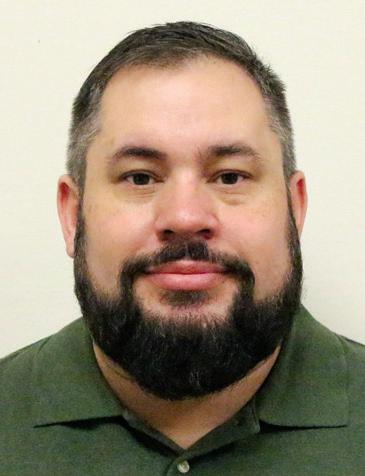
Contact Scott Bowler PSUAC Executive Director 801-538-8876 sbowler@utah.gov
Governor’s Office of Economic Development • 2017 Annual Report • www.business.utah.gov 43
Advance Partnerships
Avenue H
Purpose
U.C.A. 63N-11-101
Avenue H is Utah’s Small Business Health Insurance Marketplace Since its creation in 2009, Avenue H has helped small businesses (1-50 employees) statewide provide insurance to employees Avenue H’s process lets business owners choose a defined contribution amount for each employee In addition, employees pick their own health care benefits from a variety of medical, dental and Health Savings Accounts Enrollment is simple, taking place online and allowing employees to compare plans that will best fit their needs.
Key Initiatives
The legislative task force for health system reform officially decided to relinquish control over Utah’s state-based health insurance exchange, turning it over to the United States Department of Health and Human Services
The health system reform task force, chaired by Rep James A Dunnigan, recommended an amendment to H B 336, which the Legislature passed On May 23, 2017, Gov Herbert signed the bill into law It “amends the duties of the Office of Consumer Health Services (OCHS) within the Governor’s Office of Economic Development to require the office to wind down the small employer health insurance exchange known as Avenue H.” Key initiatives began immediately and will wrap up no later than June 30, 2018
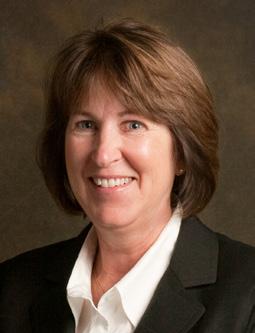
Data
Avenue H will remain open during the transition, continuing to support new and existing customers

The number of participating small businesses slightly increased during FY 2017 Total enrolled member count decreased by nearly 1,700
Today small businesses have the option to purchase group insurance direct from an insurer or through Avenue H In 2018 small businesses can visit Healthcare gov to view their group coverage options Avenue H is no longer be available to new and renewing groups effective January 1, 2018 .
Challenges and Achievements:
Uncertainty in the marketplace, fueled by an intense state and national debate over the ACA (Patient Protection and Affordable Care Act of 2010) has been the number one challenge for Avenue H
Throughout the challenges, this past year Avenue H has implemented new tools to enhance our consumer’s online shopping and enrollment experience Implementation of a comprehensive plan was also developed to “wind down” operations in a way that is least disruptive to existing members and stakeholders
Governor’s Office of Economic Development • 2017 Annual Report • www.business.utah.gov 44 Advance Partnerships
Sue Watson Director 801-538-8883 spwatson@utah.gov
Contact
Purpose
U.C.A. 63N-5
Private Activity Bond Authority
The Private Activity Bond Authority Review Board is charged with managing the state’s volume cap for the following programs: Private Activity Bond Authority Program (PAB) and the Qualified Energy Conservation Bond Program (QECB). PAB is Utah’s tax-exempt bonding authority to create a lower-cost, long-term source of capital to: 1) promote the economic health of communities by providing affordable housing; and 2) assist new or existing companies with funding for manufacturing facilities and equipment QECBs are taxable bonds issued for a number of energy conservation initiatives including energy reduction in public buildings, mass commuting facilities and energy technology research
Data: Approved Projects for CY 2016
Challenges and Achievements
The PAB Program initiated a yearly Developer’s Input Meeting starting in August 2016 Developers who use the PAB Program were invited to give their input on the new Scoring Criteria the PAB Review Board developed . The exchange of information was very helpful to staff as well as the developers It helped “smooth out some of the wrinkles” from this new initiative. Since the scoring criteria was put in place, it has become a valuable tool for the Board when facing funding decisions, especially when more applications are received than funding is available
PAB operates on a calendar year. Allocation amounts are from CY 2016, but estimated job creation figures are from CY 2016-17 due to when bonds were issued and construction commenced. Not all Multi-Family Housing projects with allocations have closed

Governor’s Office of Economic Development • 2017 Annual Report • www.business.utah.gov 45
Approved Funding Categories Volume Cap Allocation Amount Number of Projects Number of Loans for Homes Number of Permanent Jobs Created Number of Construction Jobs Number of Other Temporary Jobs Created Multi-Family Housing $176,638,000 11 N/A 10* 250* 25* Manufacturing $20,000,000 2 N/A 55 N/A N/A Single Family Homes $142,972,000 N/A 4,735 N/A 256** N/A Student Loans $0 N/A N/A N/A N/A N/A Exempt Facility Projects $16,265,000 1 N/A 30 N/A N/A Qualified Energy Conservation Bonds $0 $0 $0 $0 $0 $0
N/A – Not Applicable
* Numbers are from projects that closed in CY2016 and started construction in CY2016 or CY2017.
** Direct, Indirect and Induced Jobs.
Data goes through June 30, 2017.
Private Activity Bond Authority will be transitioned to another agency
Ginger Chinn Managing Director 801-538-8850
Contact
gchinn@utah.gov Advance Partnerships
Marketing and Communications
GOED Marketing and Communications (MarComm) is the voice of the state of Utah to the business community We promote Utah as a premier global business destination and a business friendly environment where companies can grow, engage and prosper .
We provide strategic communication direction to support the GOED programs with public relations, social media, digital and traditional advertising, events and branding MarComm serves our programs as an in-house service center for public awareness and promotional needs
Achievements
Public Relations: The team distributed or assisted with 72 press releases and facilitated more than 116 interviews and media requests resulting in coverage from local media as well as Bloomberg News, U S A Today, Company Week, Business Facilities and La Nacional Argentina. In the fiscal year, there were more than 200 articles mentioning GOED programs, state economic development initiatives and Utah accolades
Events: To support program activities and general awareness, MarComm managed out-of-state trade shows, governor’s business development trips, and business marketing sponsorships and in-state events. This represented 17 large events (such as Economic Summit, AUVSI, Governor’s No California trip, and Science Medals dinner) and 45 small events (such as exhibit tables at MWCN and Women Tech events)
Online Marketing: MarComm maintains active web, social media and email communication channels The business utah gov website, which includes searchable databases for corporate recruitment and an up-to-date newsroom, anchors these efforts. For the fiscal year, web users rose 4 .4 percent from 130,528 to 135,932 .
Through use of promoted posts, social media followers have increased 15.8 percent year-over-year from 9,210 to 10,666 Posts promoted events and services, and highlighted trends and economic accolades
Monthly emails to general business contacts extended awareness-building efforts to 12,369 individuals, up 17.2 percent from last year’s 10,551 .
Initiatives: The team was instrumental in supporting the expansion of strategic industry cluster initiatives such as the Aerospace and Diesel Tech Pathways Programs, the Outdoor Recreation Grant Program, and Technology Commercialization and Innovation Program promotion . In addition, the team supported the Point of the Mountain Development Commission, Inland Port Committee and the development of the 25K Jobs Initiative
Business Support: Five print and three radio ads with Utah-based publications and stations promoted PTAC, Broadband and other GOED services A total of 30 sponsorships drove awareness with stakeholders and out-of-state business visitors. Key efforts included the Utah Technology Council, Sundance Film Festival activities, VentureCapital org and Utah Hispanic Chamber of Commerce
In addition, the team produced 139 GOED senior management public presentations to local business and community groups These presentations routinely cover the range of services GOED offers
MarComm will lead GOED’s Business Elevated branding campaign, including the launch of a redesigned business utah gov In addition, MarComm will expand both earned and owned media through various social media outlets, multi-media content and proactive media pitching The team will work closely with each program to assist in telling the GOED story
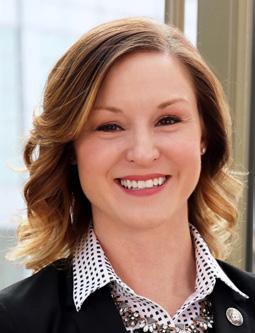
Governor’s Office of Economic Development • 2017 Annual Report • www.business.utah.gov 46 Advance Partnerships
Contact Aimee Edwards Communications Director 801-538-8811 edwards@utah.gov
Governor’s Office of Economic Development • 2017 Annual Report • www.business.utah.gov 47

Budget
FY 2017 Budget
OUTDOOR
RECREATION
*Includes one time and nonlapsing/carry forward balances
TOTAL
BUDGET
$72,494,000
Governor’s Office of Economic Development • 2017 Annual Report • www.business.utah.gov 49
BUDGET ITEM GENERAL FUND GENERAL FUND ONE TIME* GF RESTRICTED DEDICATED CREDIT TRANSPORTATION FEDERAL TOTAL BUDGET ADMINISTRATION $2,673,500 $545,300 — $340,900 — — $3,559,700 BROADBAND $353,800 $24,400 — — — — $378,200 FILM $2,799,000 $188,800 — — — — $2,987,800 PASS THRU $5,153,800 $3,130,000 — — — — $8,283,800 PETE SUAZO ATHLETIC COMMISSION $163,900 $94,300 — $67,100 — — $325,300 RURAL DEVELOPMENT $364,600 $128,100 — — — — $492,700 STEM $9,519,700 $4,603,600 — $98,000 — — $14,221,300 TOURISM MARKETING — $2,878,000 $21,000,000 — — — $23,878,000 TOURISM $3,386,600 $182,500 — $229,000 $118,000 — $3,916,100 AVENUE H $605,200 $235,100 — $850,600 — — $1,690,900 CORPORATE RECRUITMENT $2,871,200 $373,200 $250,000 $66,200 — $361,000 $3,921,600 BUSINESS SERVICES $4,344,500 $2,667,600 — $137,800 — $416,700 $7,566,600 OUTDOOR RECREATION $272,000 $1,000,000 — — — — $1,272,000 GOED BUDGET FY2017 $32,507,800 $16,050,900 $21,250,000 $1,789,600 $118,000 $777,700 $72,494,000
BROADBAND
FILM
PASS
THRU
PETE
SUAZO
ATHLETIC
COMMISSION
RURAL
DEVELOPMENT
STEM
TOURISM
MARKETING
TOURISM
AVENUE
H
CORPORATE
RECRUITMENT
BUSINESS
ADMINISTRATION
SERVICES
*Includes 1x Capital Expense
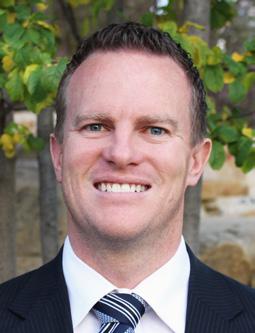
Governor’s Office of Economic Development • 2017 Annual Report • www.business.utah.gov 50 FY 2017 Expense Contact Kamron Dalton Director of Finance 801-538-8877 kdalton@utah.gov ADMINISTRATION
BROADBAND
FILM
PASS
THRU
PETE
SUAZO
ATHLETIC
COMMISSION
RURAL
DEVELOPMENT
STEM
TOURISM
MARKETING
TOURISM
AVENUE
H
CORPORATE
RECRUITMENT
BUSINESS
SERVICES
OUTDOOR
RECREATION
TOTAL
EXPENSE
$58,093,000 BUDGET ITEM PERSONNEL TRAVEL CURRENT EXPENSE* DATA PROCESSING DTS GRANTS/PASS THROUGH TOTAL EXPENSE ADMINISTRATION $1,814,000 $41,000 $856,000 $214,000 $86,000 $3,011,000 BROADBAND $152,000 $8,000 $172,000 $19,000 — $351,000 FILM $472,000 $21,000 $226,000 $19,000 $1,575,000 $2,313,000 PASS THRU — — — — $7,970,000 $7,970,000 PETE SUAZO ATHLETIC COMMISSION $132,000 $17,000 $39,000 $4,000 $8,000 $200,000 RURAL DEVELOPMENT $262,000 $8,000 $24,000 $4,000 $20,000 $318,000 STEM $900,000 $26,000 $3,535,000 $76,000 $5,248,000 $9,785,000 TOURISM MARKETING — $16,000 $14,055,000 — $5,313,000 $19,384,000 TOURISM $1,764,000 $103,000 $1,613,000 $79,000 $184,000 $3,743,000 AVENUE H $466,000 $1,000 $631,000 $16,000 — $1,114,000 CORPORATE RECRUITMENT $1,607,000 $69,000 $1,408,000 $29,000 $436,000 $3,549,000 BUSINESS SERVICES $1,244,000 $51,000 $1,978,000 $50,000 $2,454,000 $5,777,000 OUTDOOR RECREATION $274,000 $9,000 $12,000 $3,000 $280,000 $578,000 GOED BUDGET FY2017 $9,087,000 $370,000 $24,549,000 $513,000 $23,574,000 $58,093,000
Governor’s Office of Economic Development • 2017 Annual Report • www.business.utah.gov 51

Boards & Councils
Boards & Councils
GOED Board of Directors
Purpose: The Governor’s Board of Business and Economic Development consists of 15 members appointed to four-year terms by the governor with the advice and consent of the Senate The Governor’s Board of Business and Economic Development is charged with promoting and encouraging the economic, commercial, financial, industrial, agricultural, and civic welfare of the state . The board also advises the Governor’s Office of Economic Development staff on the development, attraction, retention and expansion of businesses, industries and commerce within the state
Members:
Jerry Oldroyd, Chairman, Ballard Spahr
Mel Lavitt, Needham and Company
Peter Mouskondis, Nicholas and Co
Margaret Jacobs, Sundance Institute Board
Carine Clark, Banyan and Silicon Slopes Board
Bob Frankenberg, NetVentures
Lorena Riffo-Jenson, VOX Creative
Bevan Wilson, Emery County
Steve Neeleman, HealthEquity
Annette Meier, SDPI
Stefanie Bevans, Design to Print
Ted Wilson, former UCAIR executive director and former mayor, Salt Lake City
Sue Johnson, Futura Industries
Brent Brown, Brent Brown Automotive Group
Christopher M Conabee, Paladin Development Partners
Code reference: 63N-1-401
Major Initiatives: Better service to rural Utah Ramped up business expansion and recruitment Pushing forward on workforce initiatives
Governor’s Economic Development Coordinating Council (GEC)
Purpose: The Governor’s Economic Council (GEC) is a public-private partnership that coordinates economic development activities throughout the state Council membership is based on each appointee’s leadership at economic development organizations throughout Utah GEC members focus on forging and maintaining unprecedented partnerships between business and
government to coordinate public and private efforts and further develop Utah’s growing economy
Members:
Q Val Hale, Chair, Executive Director, Governor’s Office of Economic Development
Mel Lavit, Chair, GOED Incentives Subcommittee
Susan Opp, L-3 Communications, Board Chair, USTAR Governing Authority
Steve Styler, Styler Daniels, Co-Chair, GRPB
Scott Peterson, Board Chair, Utah Capital Investment Corporation
Dean Luikart, Wells Fargo, Chair, EDCUtah Board of Trustees
Scott Anderson, Zions Bank, Chair, World Trade Center Utah Board
Vance Checketts, EMC Corporation
Sarah Lehman, ENVE Composites
Cydni Tetro, Women Tech Council
Randy Tymofichuk, BAE Systems
Code Reference: 63N-1-501
Major Initiatives:
• Presentation and discussion with Envision Utah on the Point of the Mountain Commission
• Presentation and discussion regarding Utah’s efforts to establish an Inland Port
Governor’s Rural Partnership Board
Purpose: The Governor’s Rural Partnership Board was established legislatively in 2004 through SB 50 Rural Planning and Development, “to develop and prepare an annual strategic plan to address rural economic development, planning, and leadership training challenges, opportunities, priorities, and objectives”
As part of its statutory role, The Governor’s Rural Partnership Board (GRPB) serves as a voice for rural Utah to both the Executive and Legislative branches of state government in matters of rural economic and community development
Members:
Lt Governor Spencer Cox, Co-Chair, Governors Designee
Steve Styler, Co-Chair - Co-Chair, At-Large
Wes Curtis, SUU, President Designee
Michael McCandless, At-Large, Community
Governor’s Office of Economic Development • 2017 Annual Report • www.business.utah.gov 53
& Business Development
Carl R Albrecht, Rural Utilities
Brian Higginbotham, USU, President Designee
Brandy Grace, Utah Association of Counties
Charlie DeLorme, Tourism
Debbie Hatt, Associations of Government
Jason Yerka, At- Large
Brian Raymond, At- Large
Michael McKee, At- Large
Shirlee Silversmith, Utah Division of Indian Affairs
Stephen Lisonbee, Department of Workforce Services
Shannon Ellsworth, At-Large, Small Business
Tim T Munns, Agriculture Representative
Major Initiatives: The GRPB is an active participant in the 25K Jobs initiative announced by Gov Herbert in the State of the State address in January 2017 The initiative challenges the state to unite behind Lt Gov Cox and the Rural Partnership Board, along with the private sector, several state agencies and the Legislature, to ensure that economic opportunities are made available to all Utahns
In collaboration with the Office of Rural Development, the diverse membership of the Governor’s Rural Partnership Board and its executive committee have been actively engaged in meeting with all rural economic development directors to determine the top priorities in rural Utah in order to increase job growth off the Wasatch Front, and unite behind the governor’s goal of 25,000 Jobs in 25 rural counties by 2020
Code Reference: 63C-10-103
Utah Board of Tourism Development
Purpose: The board advises the Utah Office of Tourism on the office’s planning, policies, and strategies and on trends and opportunities for tourism development that may exist in the various areas of the state
The Board:
1) Has authority to approve a tourism program of out-of-state advertising, marketing, and branding, taking into account the long-term economic trends, and opportunities for tourism development on a statewide basis as a condition of the distribution of funds from the Tourism Marketing Performance Account and Stay Another Day and Bounce Back Account [there will be no money in the Stay Another Day and Bounce Back Account until the convention center hotel is constructed and operating];
2) Shall review office programs to coordinate and integrate advertising and branding themes, which may include recreational, scenic, historic, and tourist attractions of the state;
3) Shall encourage and assist in coordinating activities of persons, firms, association, corporations, civic groups, and governmental agencies that are engaged in publicizing, developing, and promoting the scenic attractions and tourist advantages of the state;
4) Shall advise the office in establishing a cooperative program using funds from the Tourism Marketing Performance Account
Members:
Lance Syrett, Chair – lodging industry
Nathan Rafferty, Vice Chair – ski industry
Greg Miller – Salt Lake, Tooele, and Morgan County
Kym Buttschardt – Davis, Weber, Box Elder, Cache and Rich County
Ryan Starks – Utah, Summit, Juab and Wasatch County
Elaine Gizler – Carbon, Emery, Grand, Duchesne, Daggett and Uintah County
John Holland – San Juan, Piute, Wayne, Garfield, and Kane County
Shayne Wittwer – Washington, Iron, Beaver, Sanpete, Sevier and Millard County
Glen Overton – restaurant industry
Mike Taylor – motor vehicle rental industry
Brian Merrill – business, finance, economic policy or the academic media marketing community
Sara Toliver – Utah Tourism Industry Association (formerly known as the Utah Tourism Industry Coalition)
Zachary Renstrom – state counties
Code Reference: 63N-7-1, sections 101-103
Major Initiatives: Approved allocation of funds from the Tourism Marketing Performance Account to projects such as three-season campaigns, a grant for Visit Salt Lake, funding support for Tour of Utah and the pending construction of the St George Welcome Center
Private Activity Bond Review Board
Purpose: The Private Activity Bond Review Board is made up of 11 members, appointed by the governor The board is responsible for overseeing the allocated volume cap of private activity bonds as determined by the Department of the Treasury . The board reviews applications, determines the allocation, and maintains
Governor’s Office of Economic Development
2017 Annual Report
www.business.utah.gov 54
•
•
records of all bonds issued within each calendar year
Members:
Bryan Thompson, Auditor, Utah County
David Feitz, Executive Director, UHEAA
David Damschen, Utah State Treasurer Utah
James Davidson, Assistance City Manager, Orem City
Grant Whitaker, President & CEO, Utah Housing Corp
John T Crandall, Executive VP, George K Baum
Wayne Cushing, Salt Lake County
Risky Hatch, Auditor, Weber County
Scott Bond, Assistant Chief Administrative Officer, Sandy City
Thomas Wadsworth, Manager, Business Development, GOED
Wayne C Parker, Chief Administrative Officer, City of Provo
Code Reference: 63N-5-103
STEM Action Center Board
Purpose: The Utah STEM Action Center Board coordinates STEM activities among stakeholders including the State Board of Education, school districts and charter schools, the State Board of Regents, higher education, parents of home-schooled students and other state agencies The Board oversees activities to align public education STEM activities with higher education as well as industry and promotes best practices in these endeavors
Members:
Bert VanderHeiden, ATK
Blair Carruth, Utah System of Higher Ed
Dave Woolstenhulme, Utah College of Applied Tech
Jon Pierpont, Department of Workforce Service
Kathleen Riebe, State Board of Education
Mark Sunday, Oracle
Mikal Ann Byrd, Chevron
Rich Nelson, Utah Technology Council
Scott Nowlin, BAE Systems
Sydney Dickson, State Superintendent
Tami Pyfer, Governor’s Ed Advisor
Val Hale, GOED
Vance Checketts, Chair, Dell EMC
Code: 63N-12-203
Governor’s Office of Economic Development • 2017 Annual Report
www.business.utah.gov 55
•
Governor’s Office of Economic Development
• 2017 Annual Report
c
• www.business.utah.gov
Vision Statement
Utah will lead the nation as the best performing economy and will be recognized as the premier global business environment and tourist destination
Mission Statement
GOED’s mission is to enhance quality of life by increasing and diversifying Utah’s revenue base and improving employment opportunities
World Trade Center at City Creek 60 E South Temple, 3rd Floor Salt Lake City, Utah 84111
801-538-8680
business .utah .gov
Annual Report
www.business.utah.gov d
Governor’s Office of Economic Development • 2017
•




























































